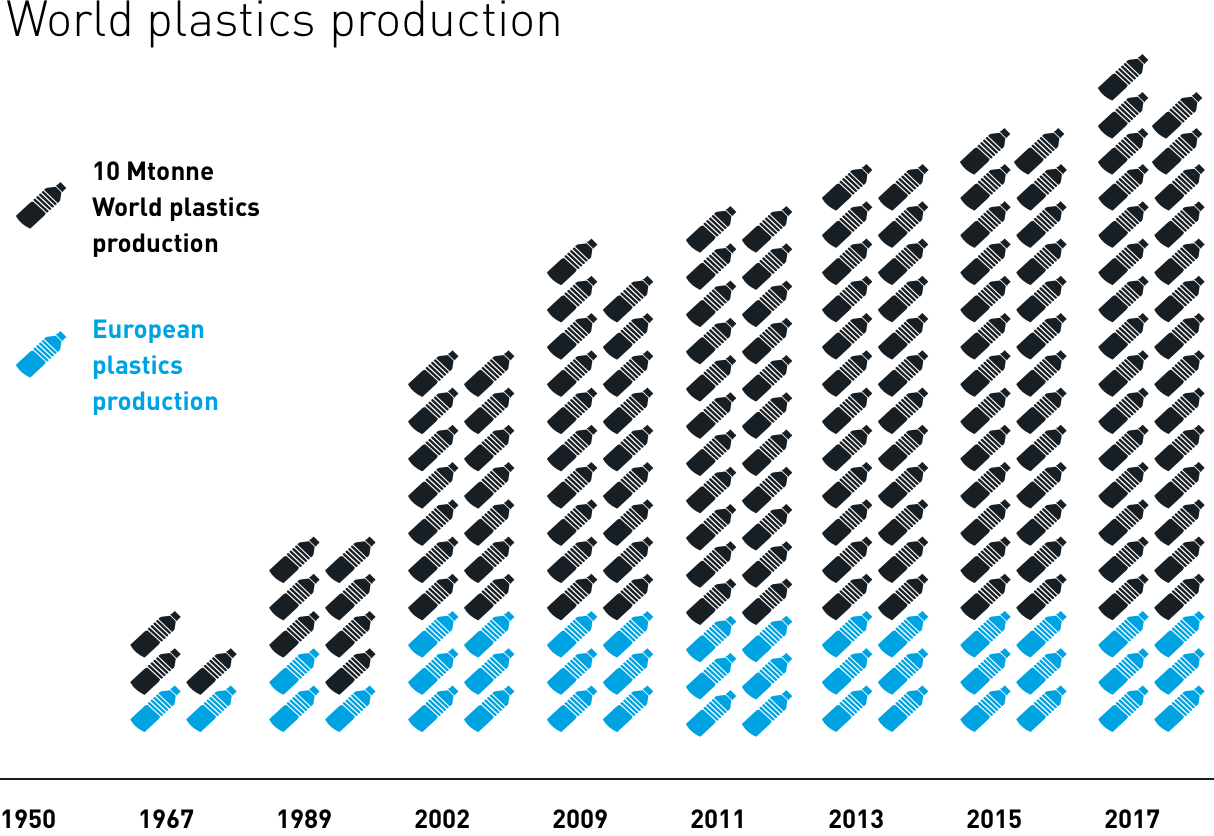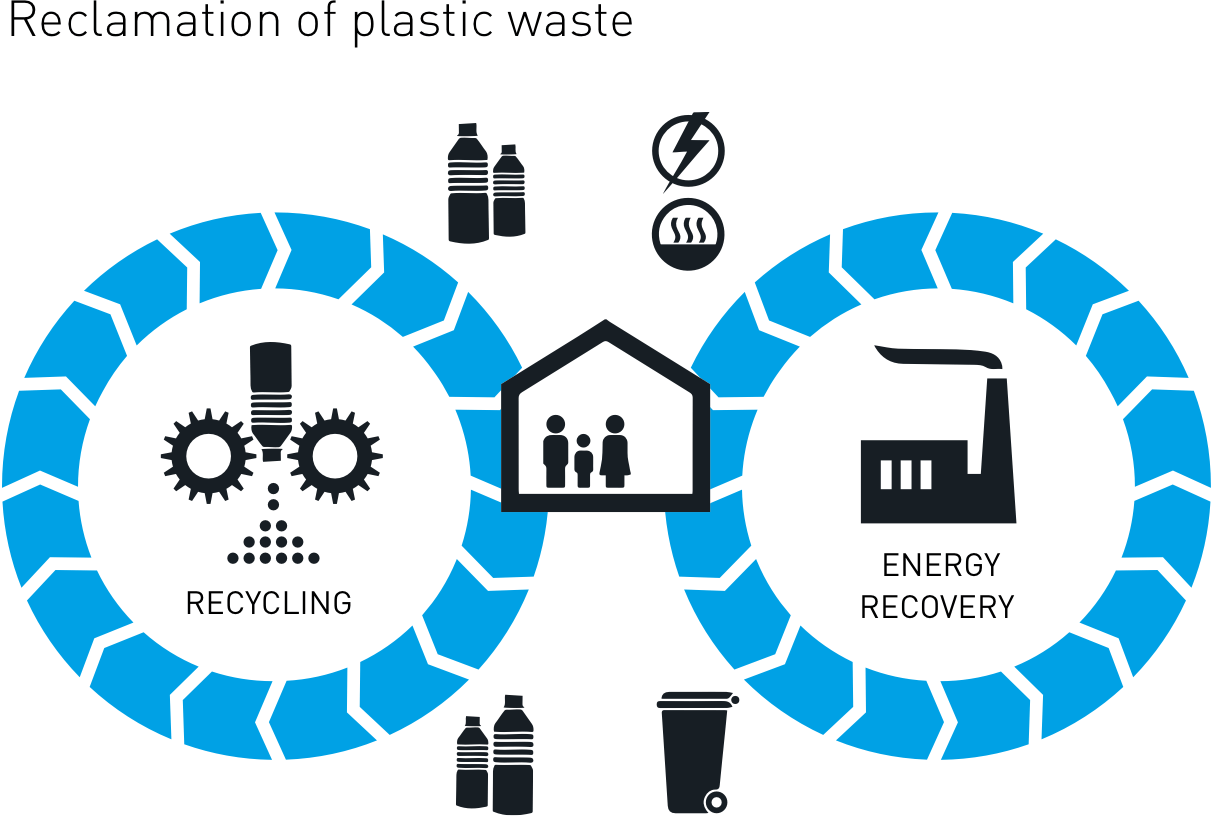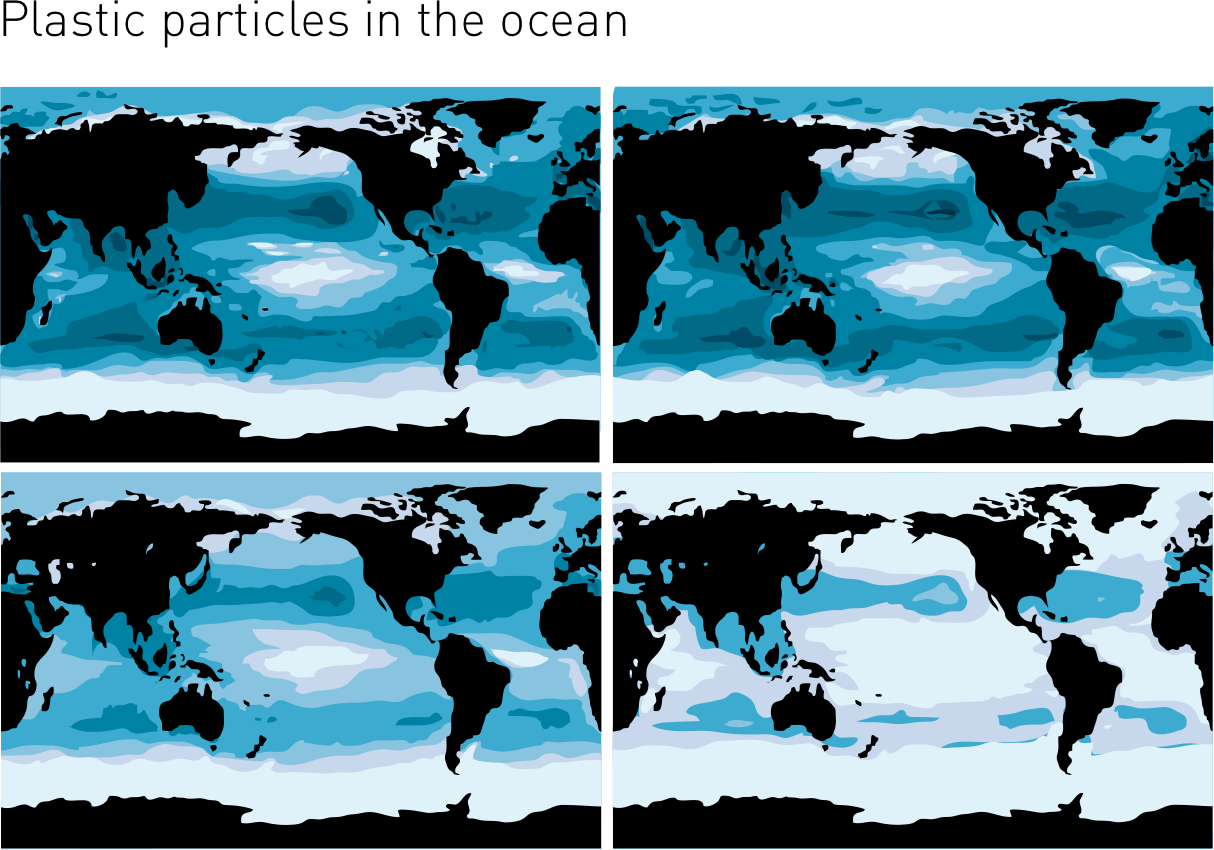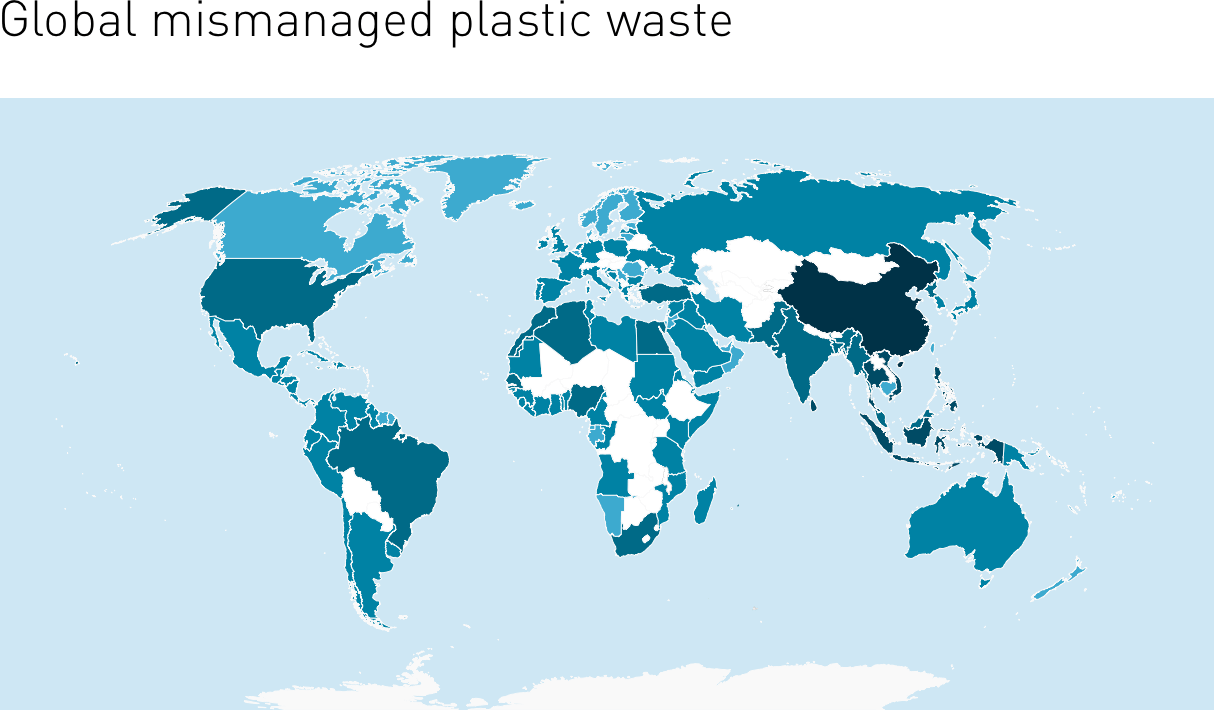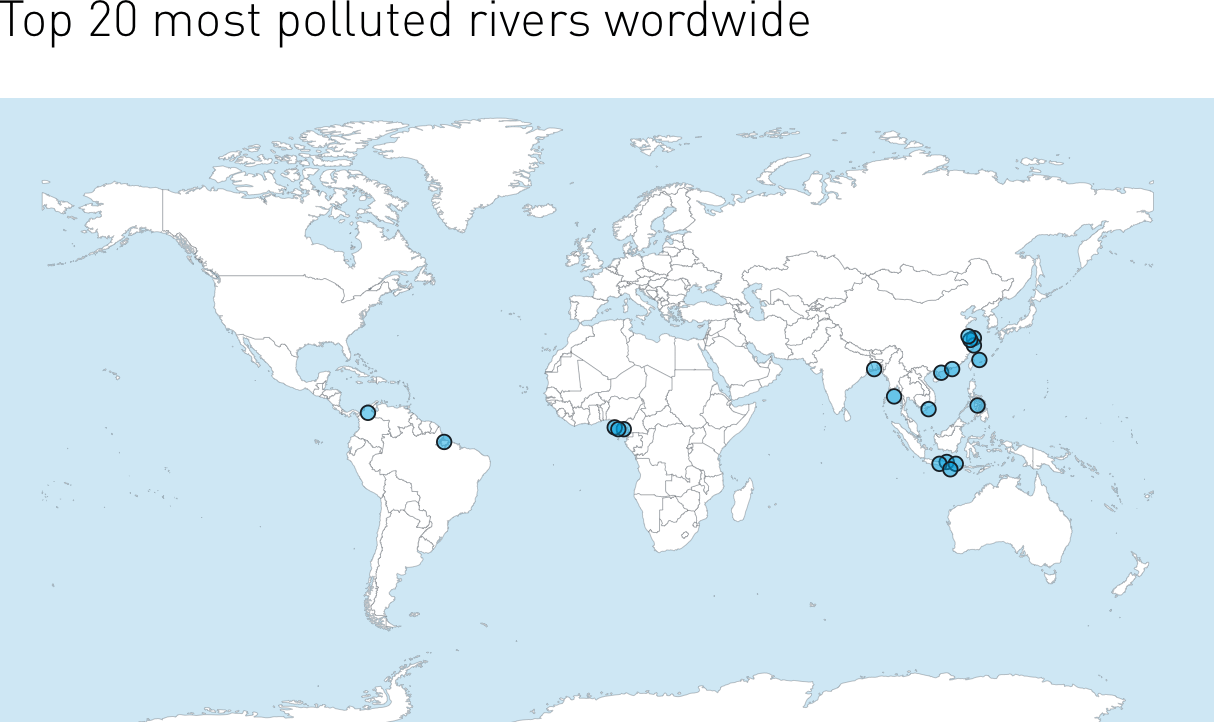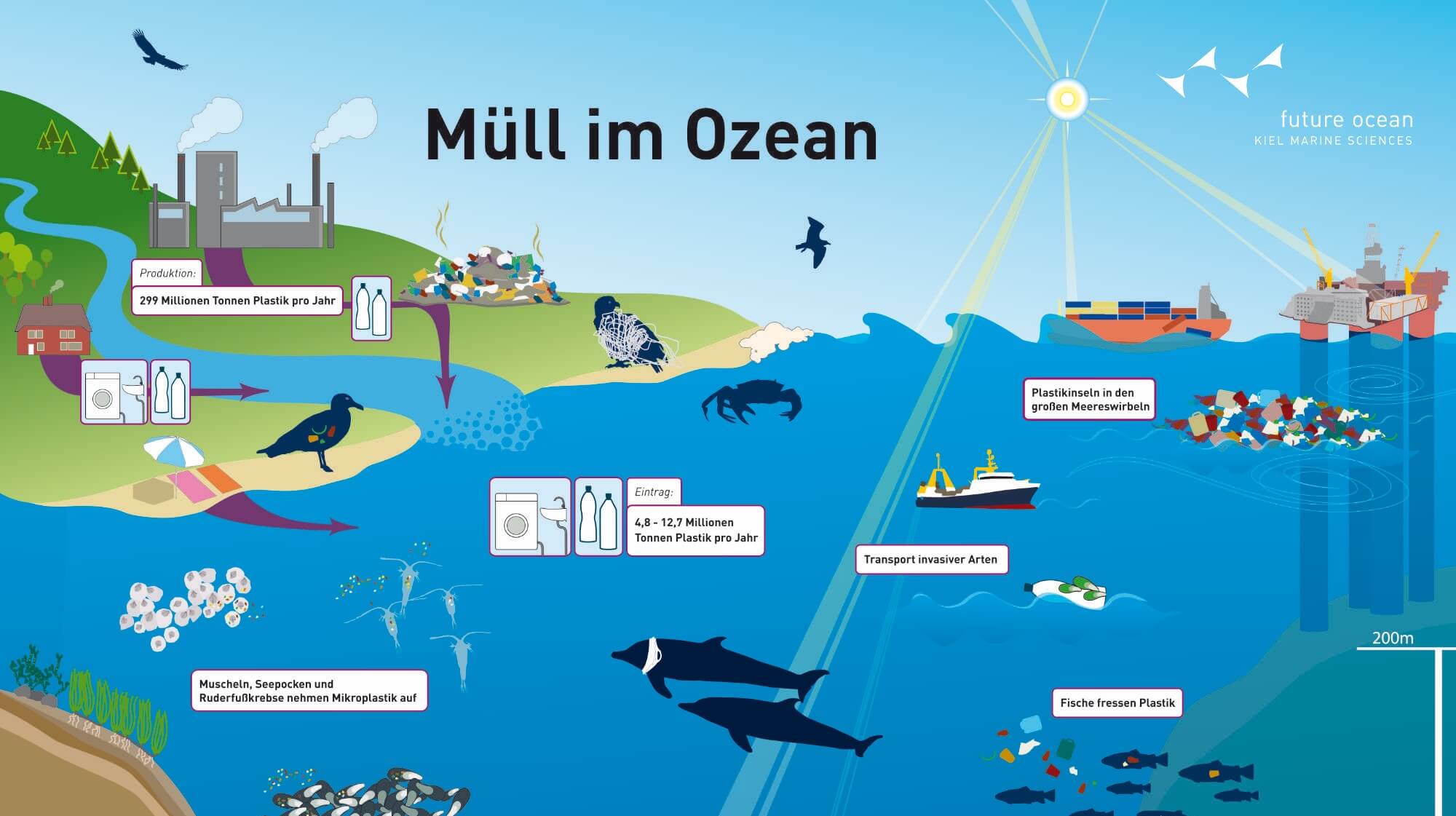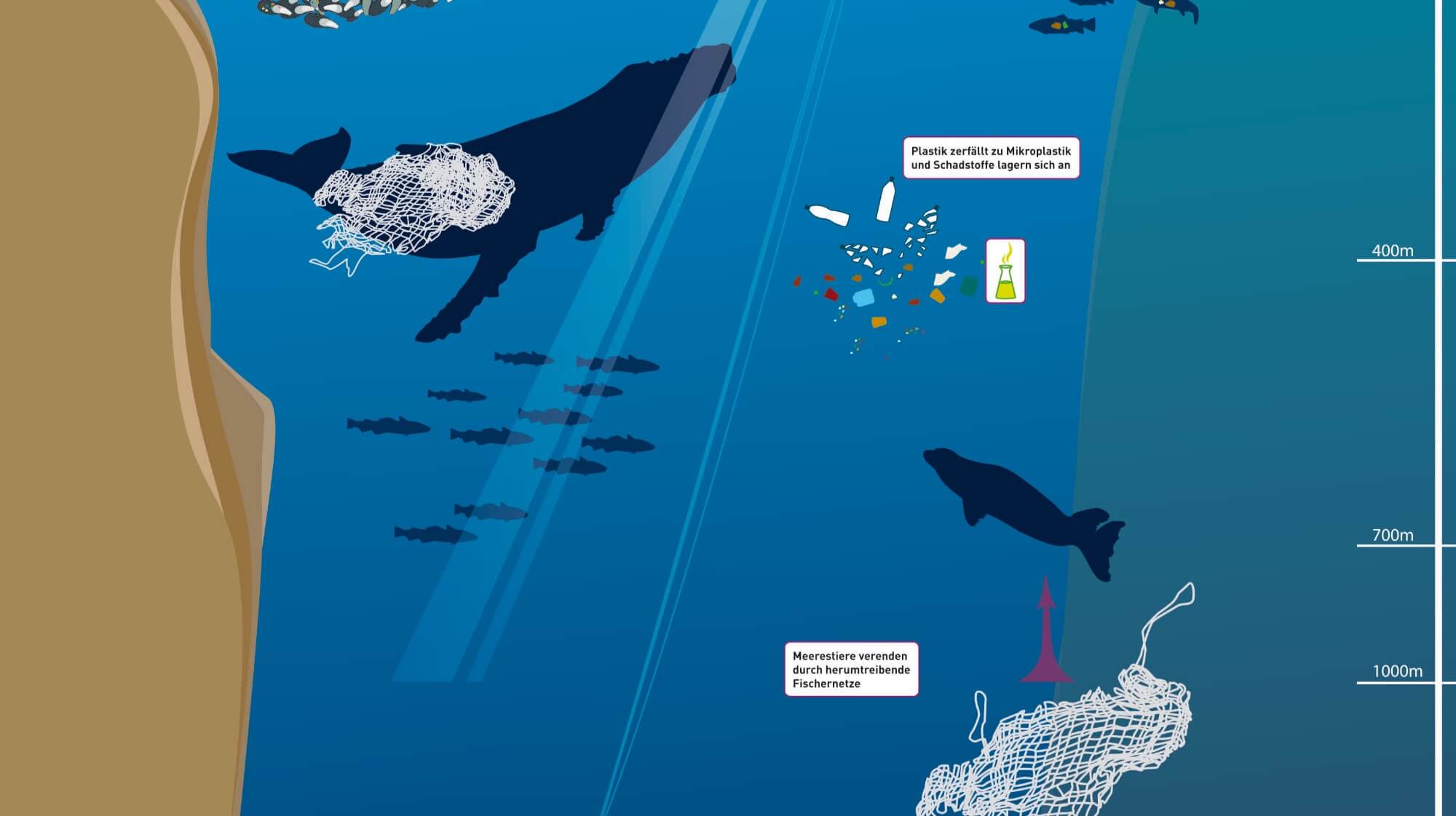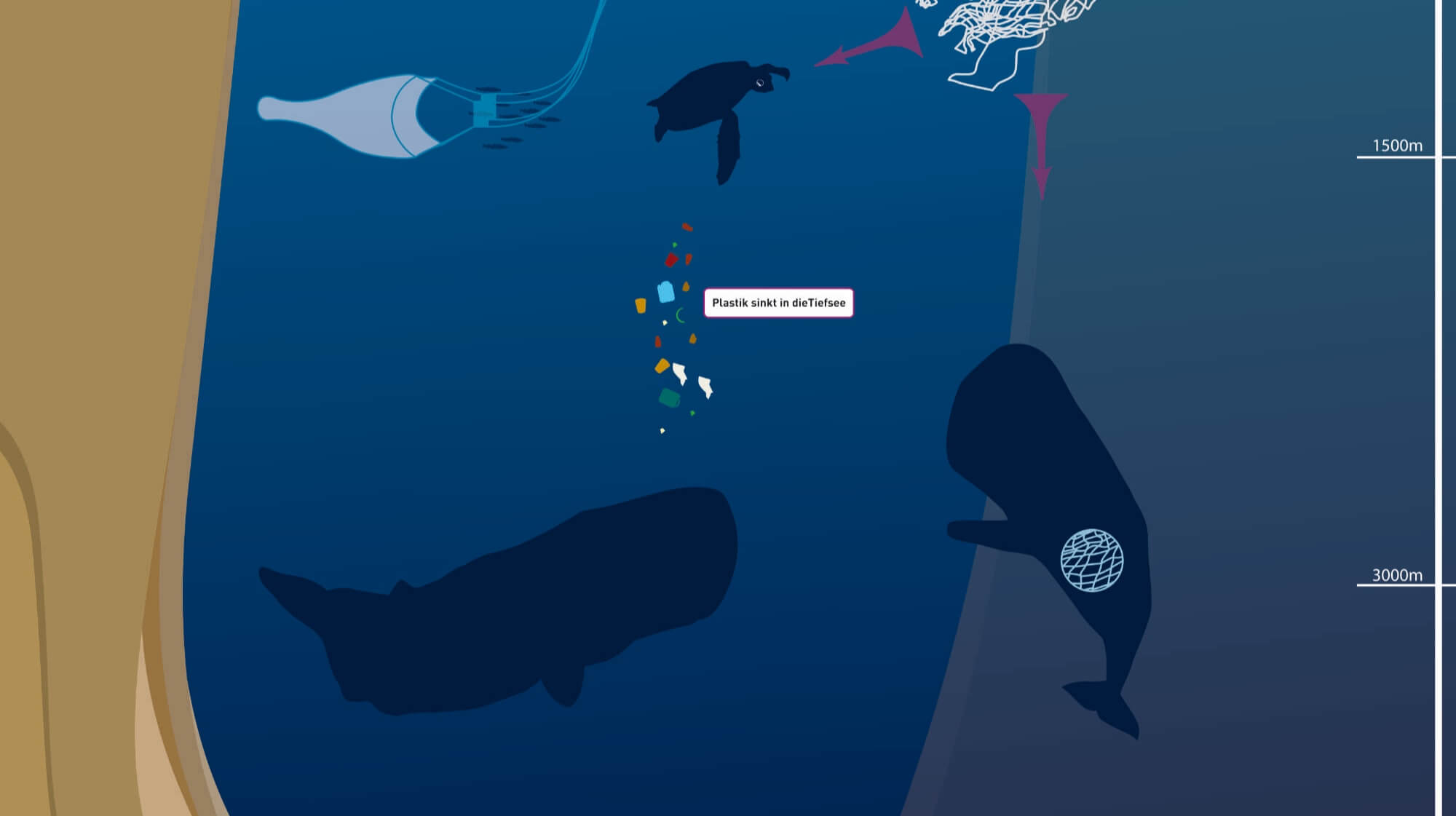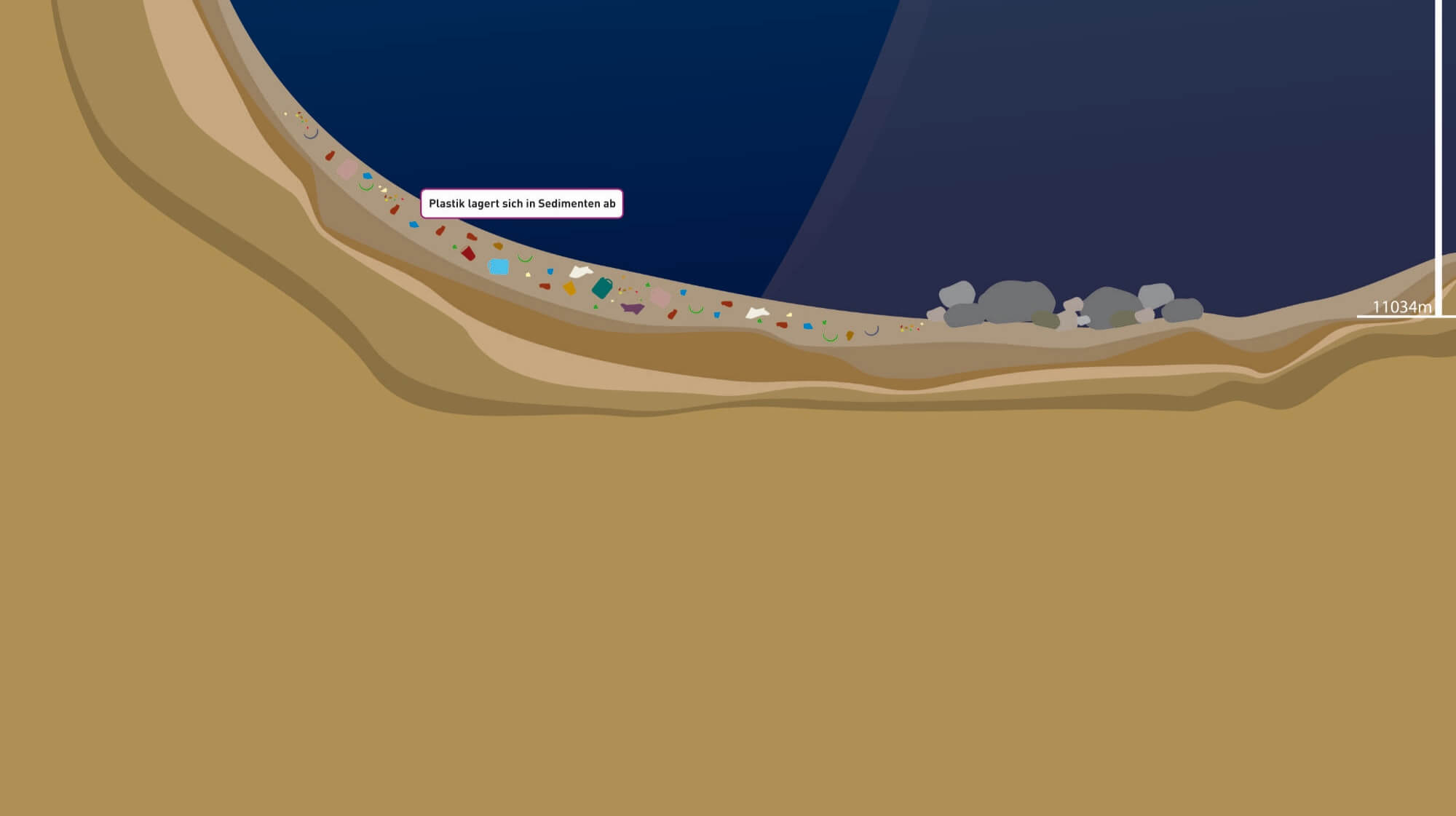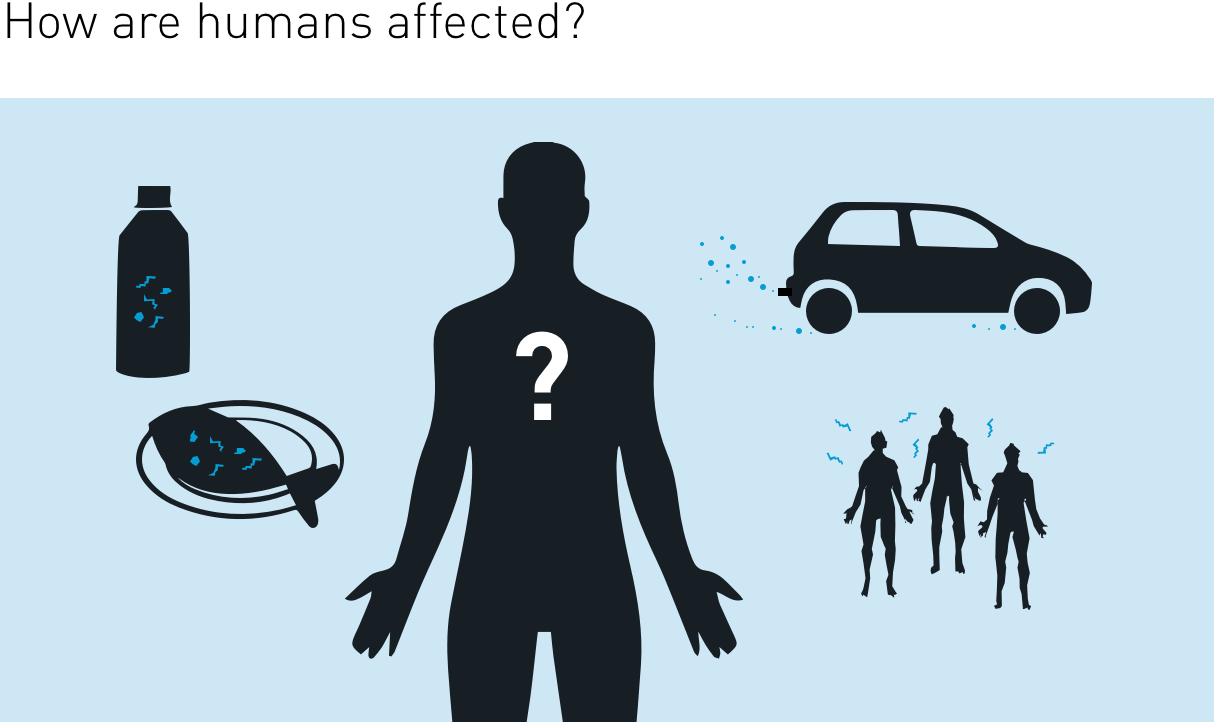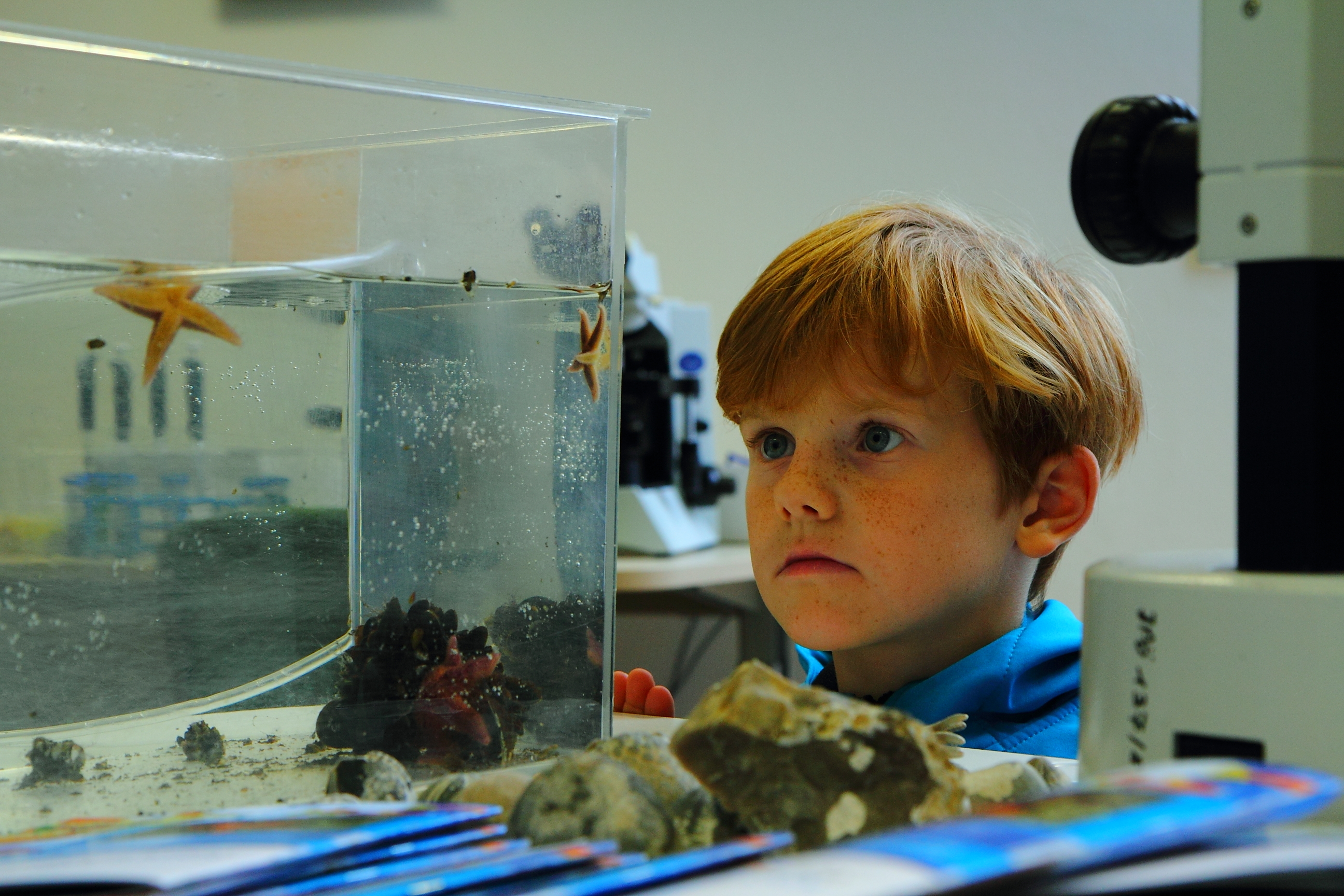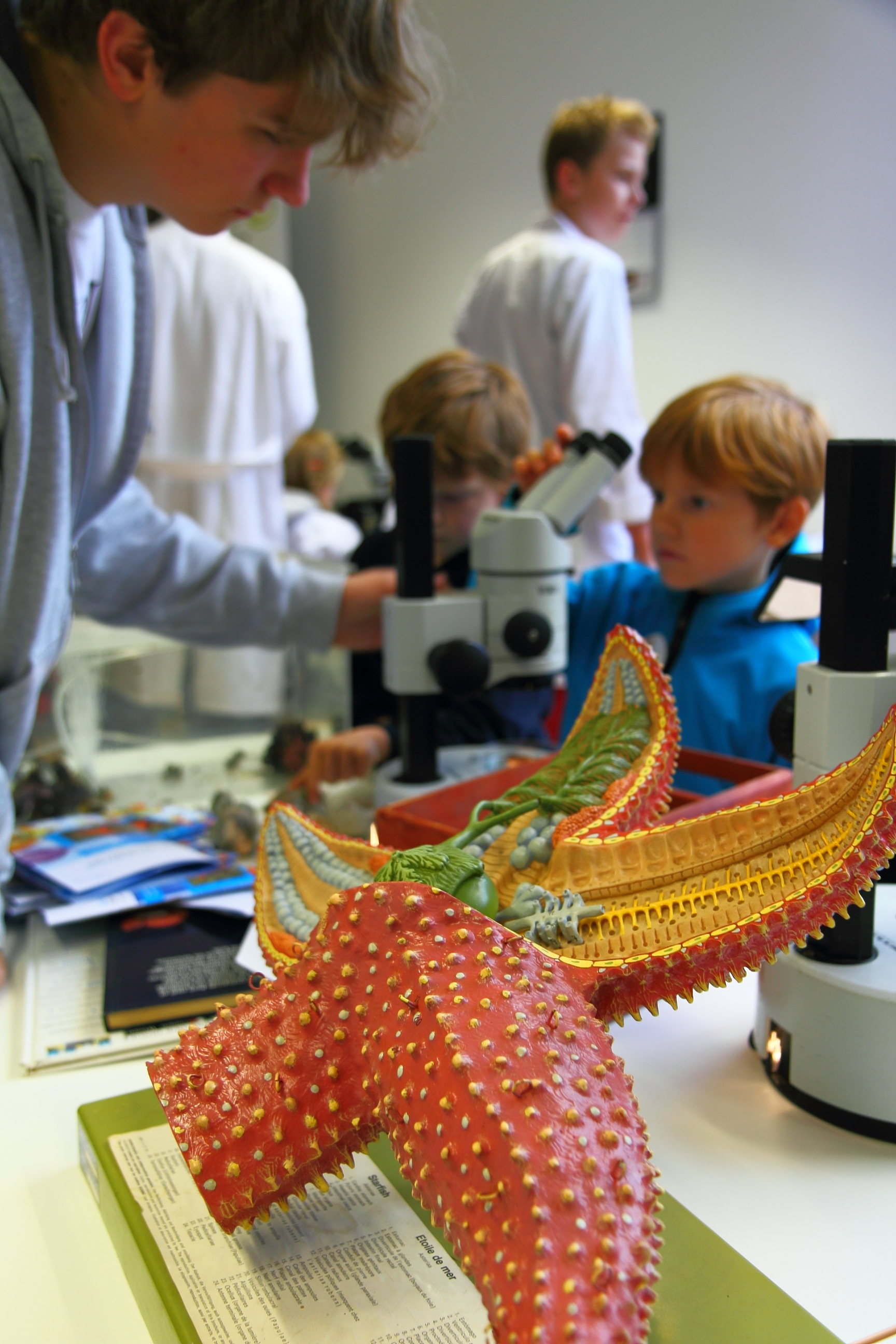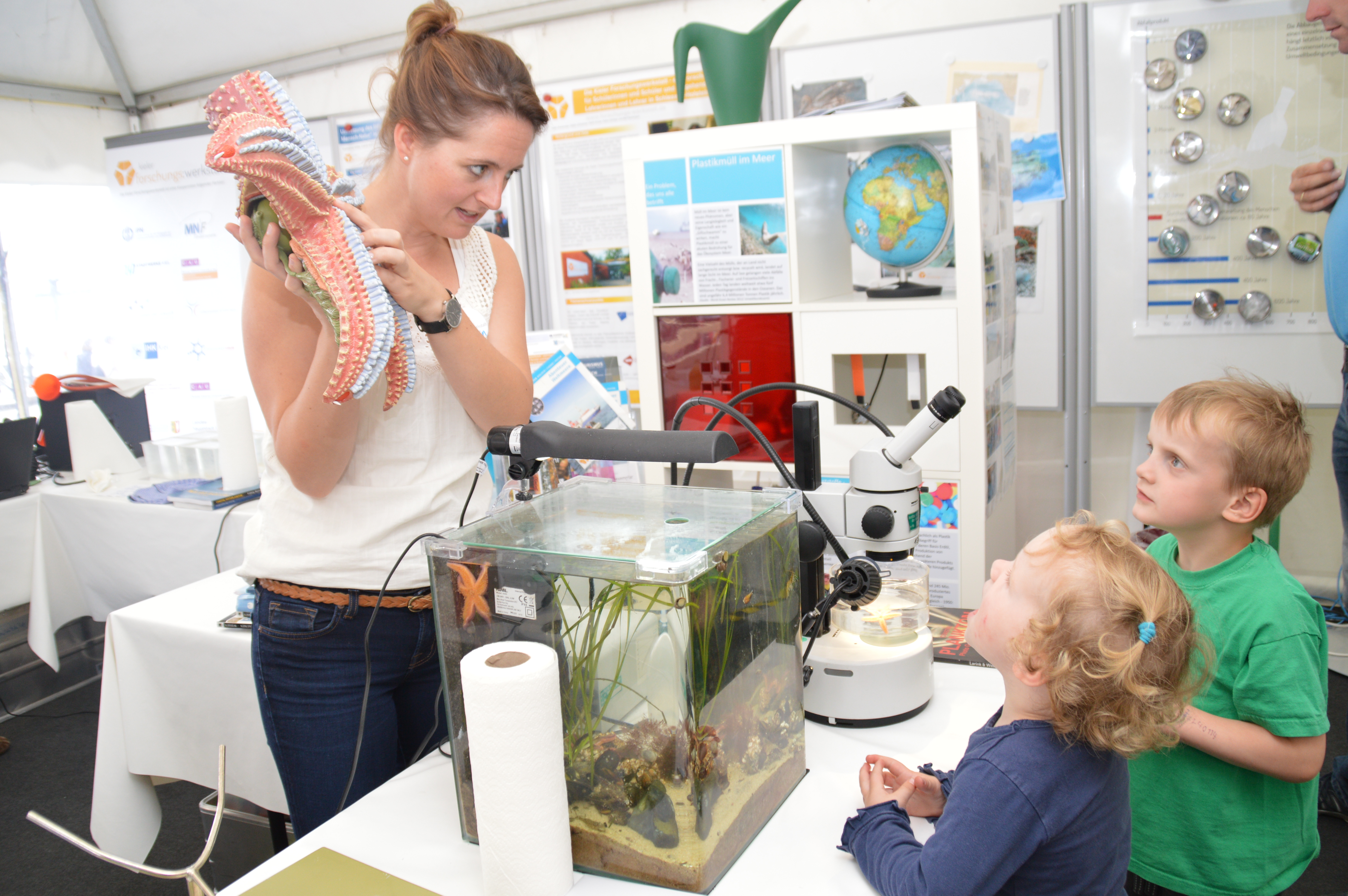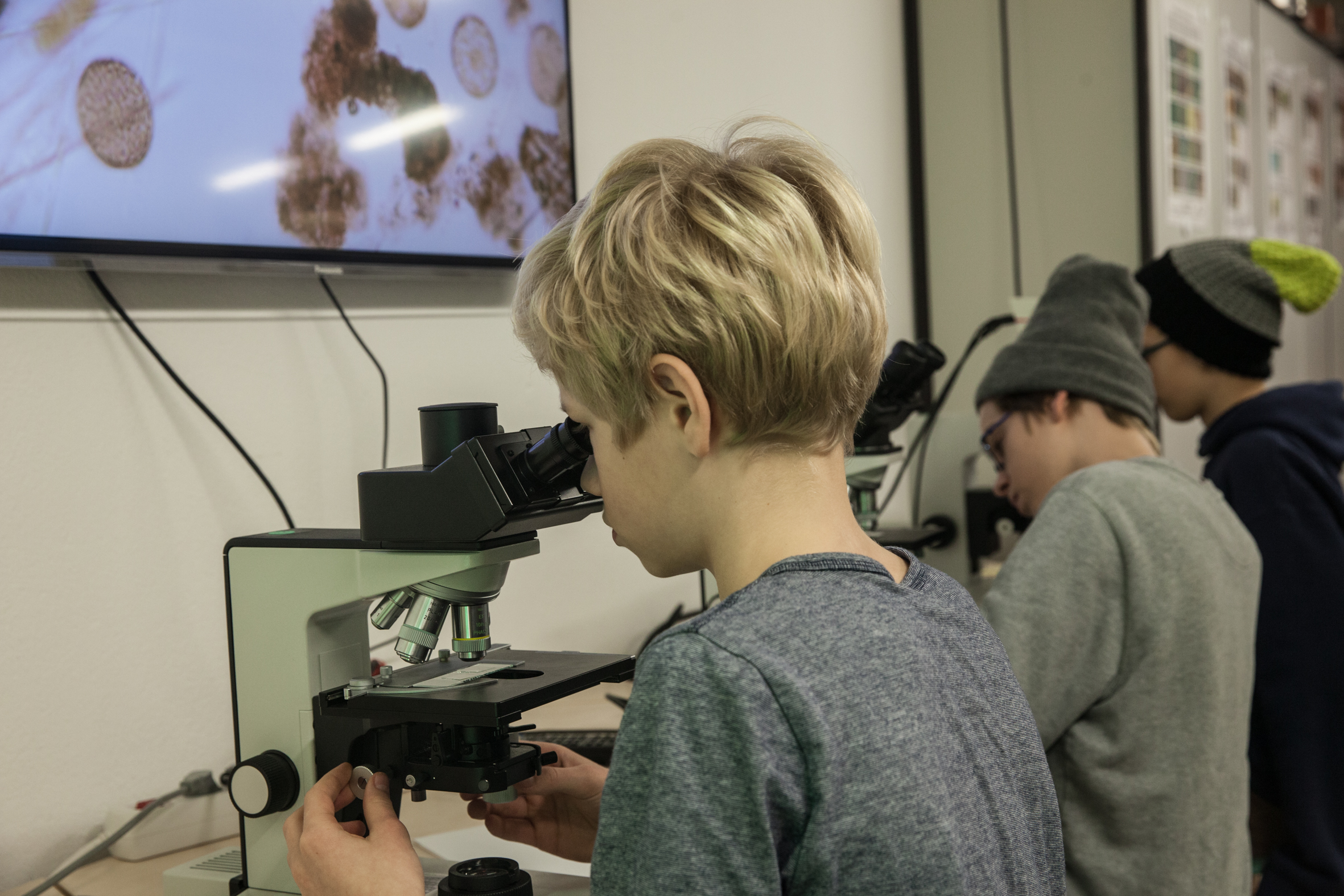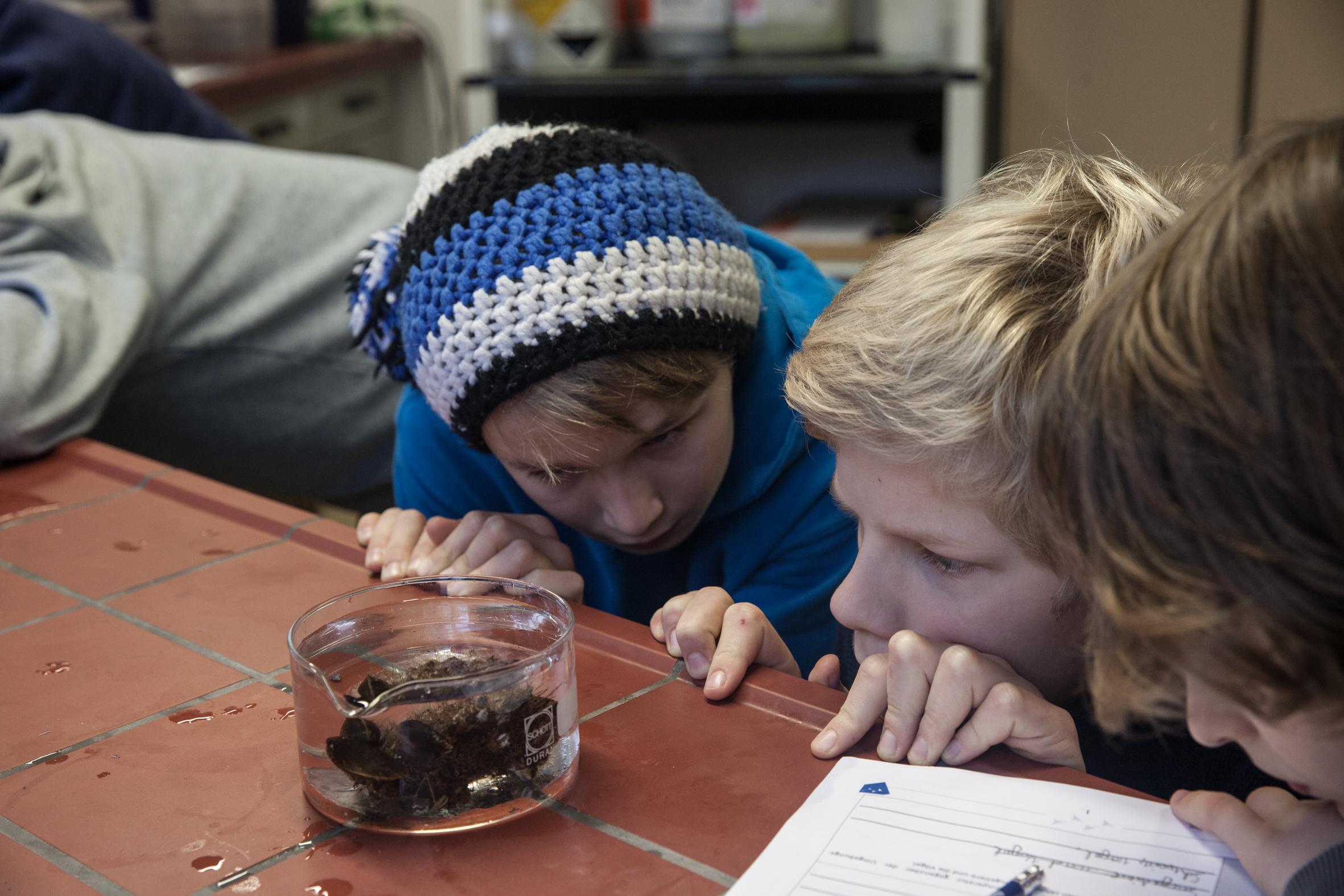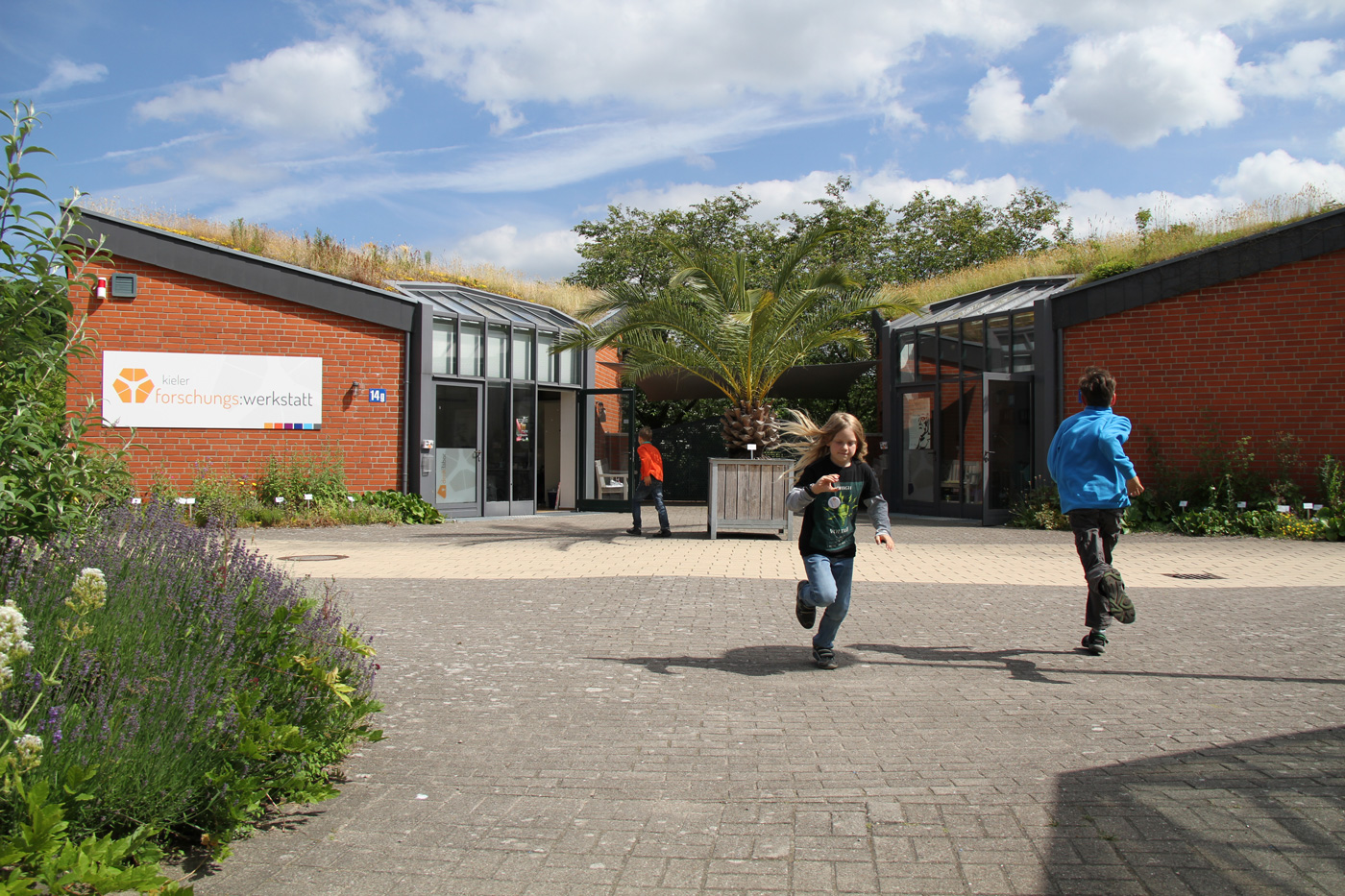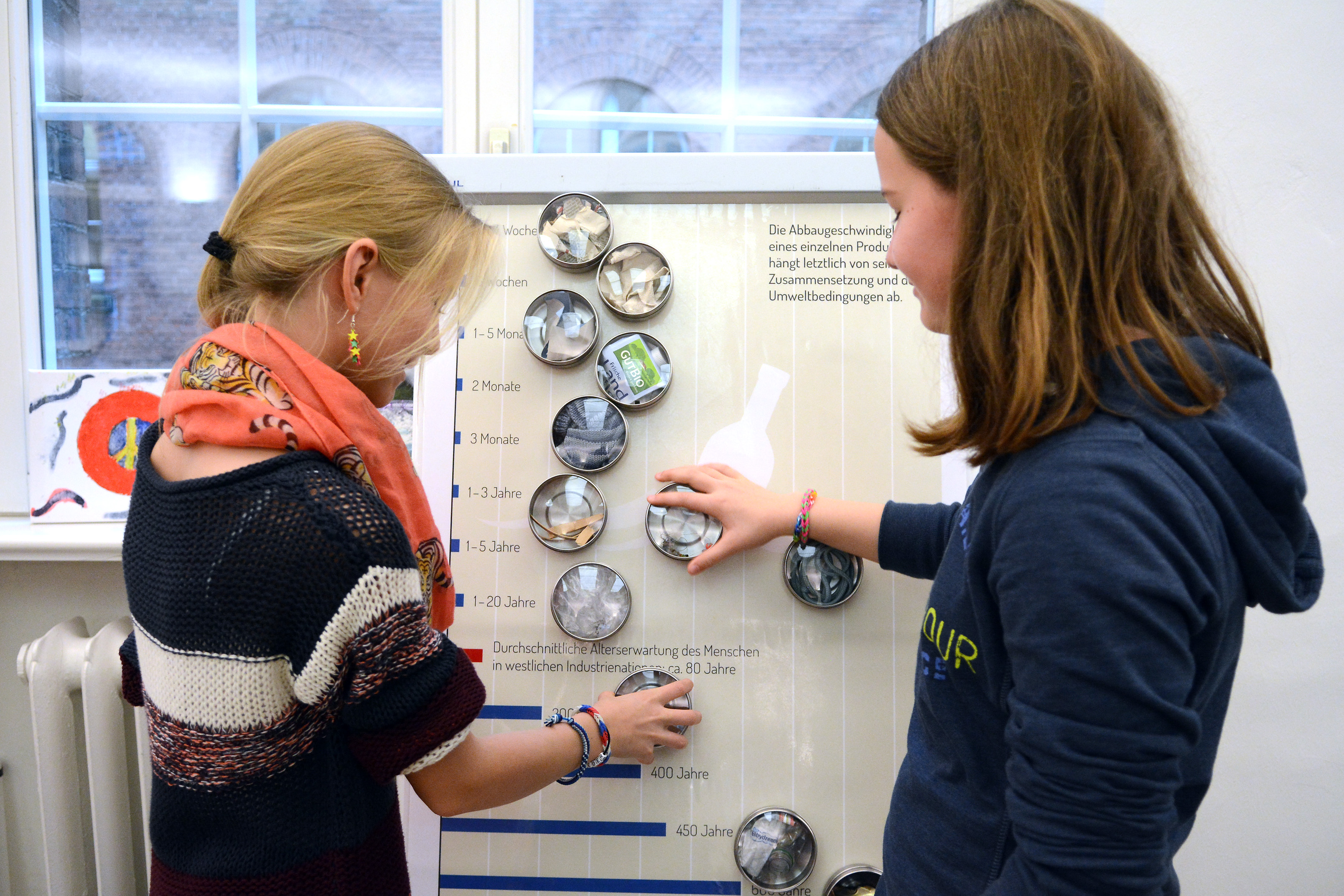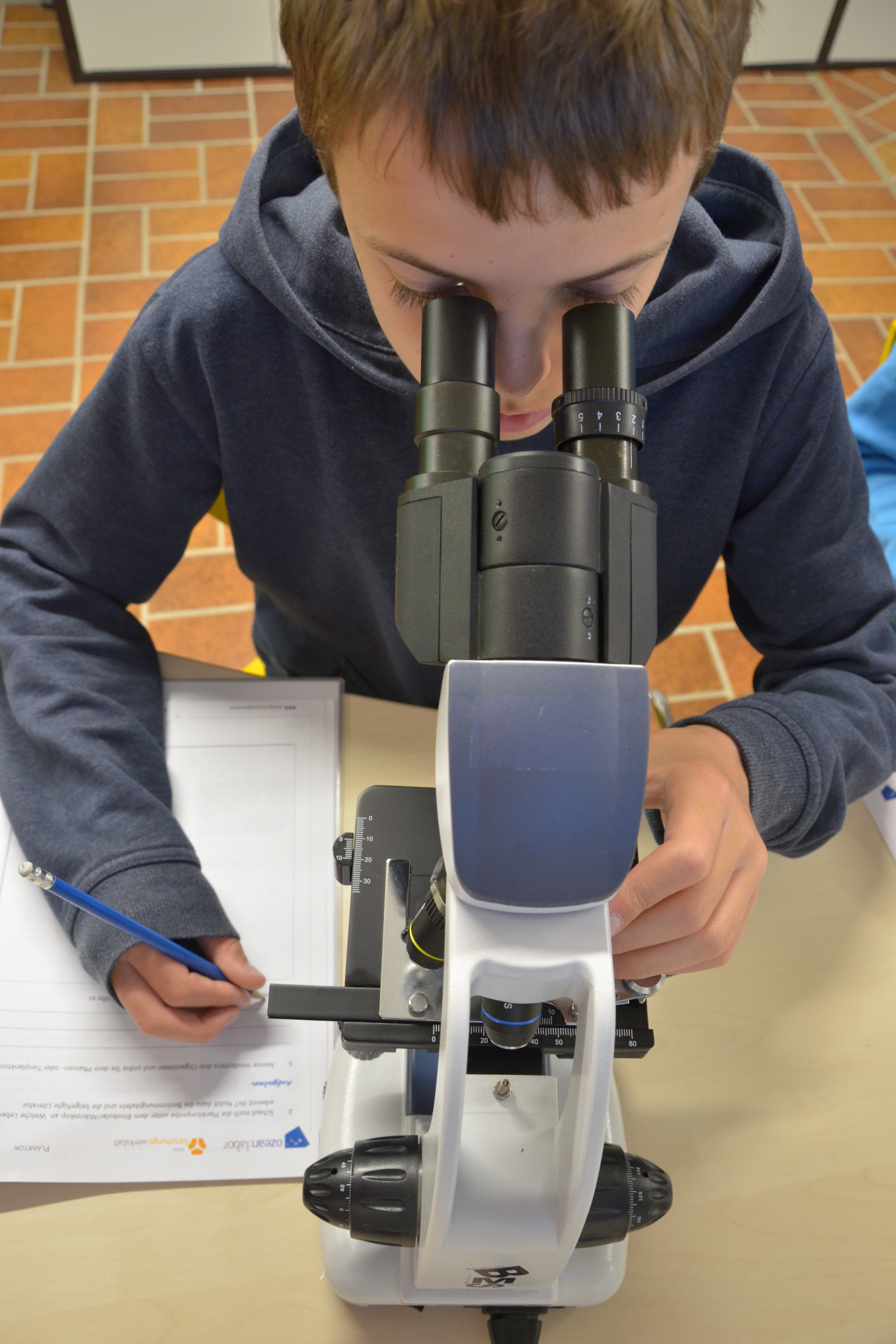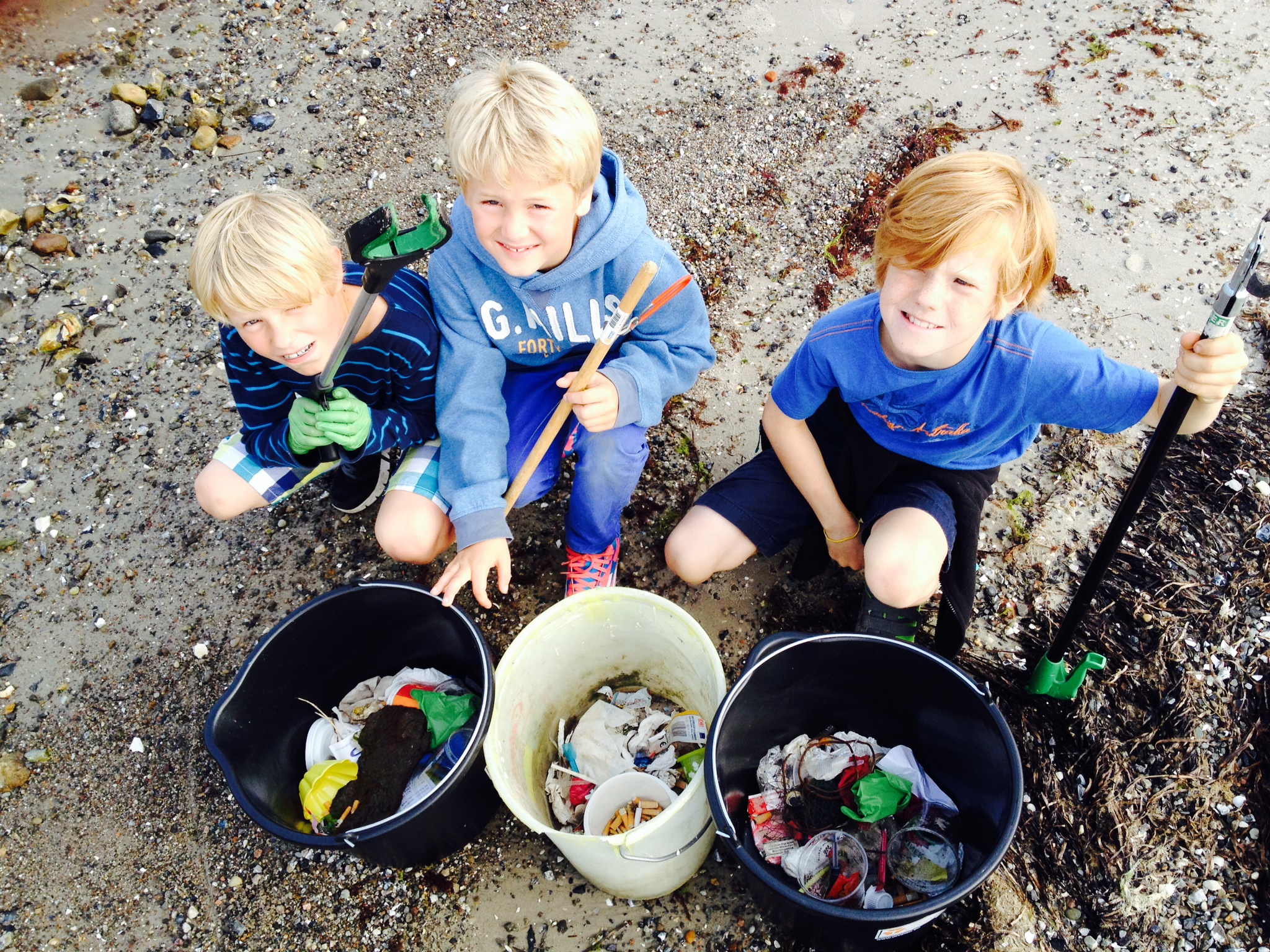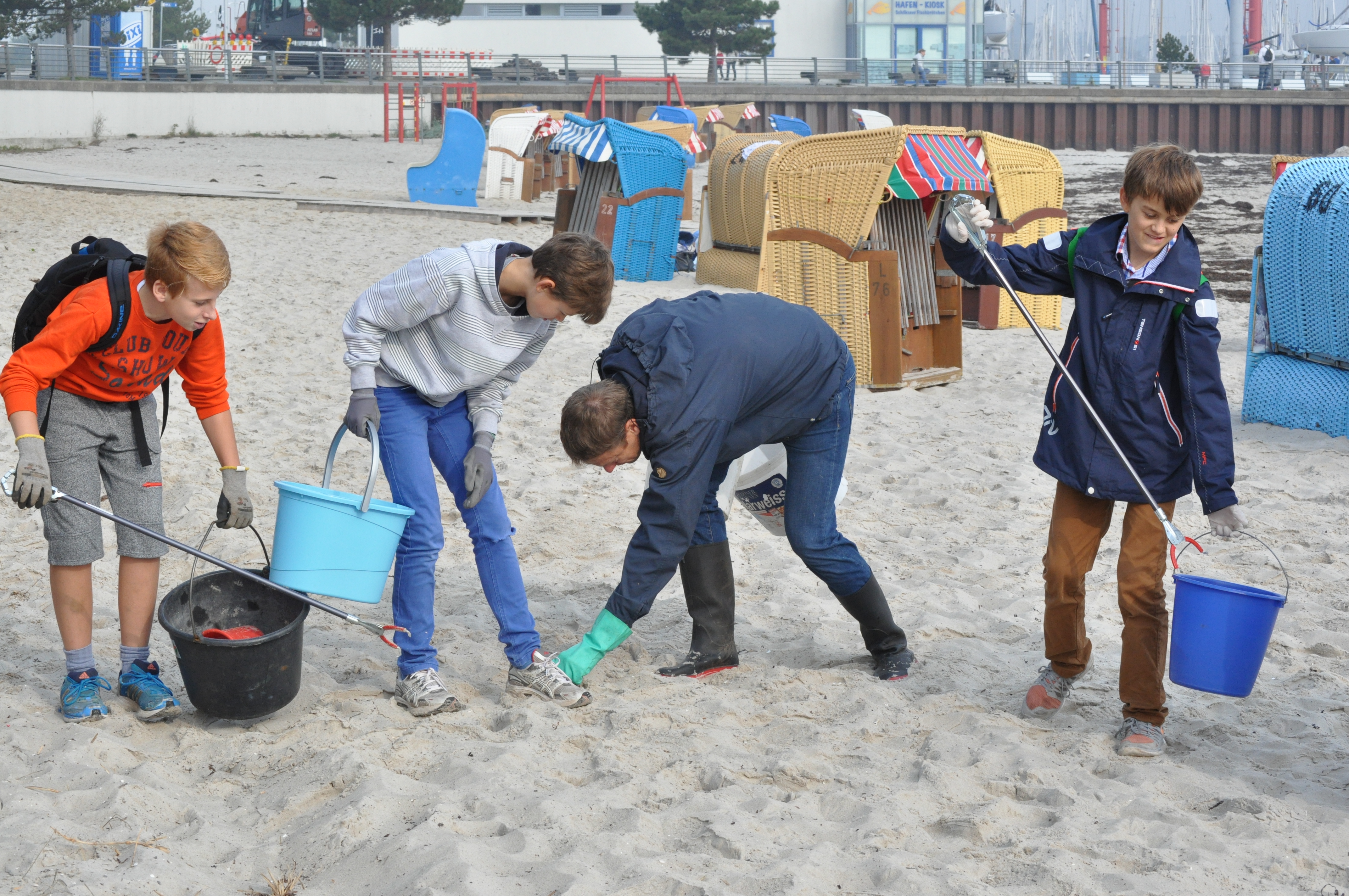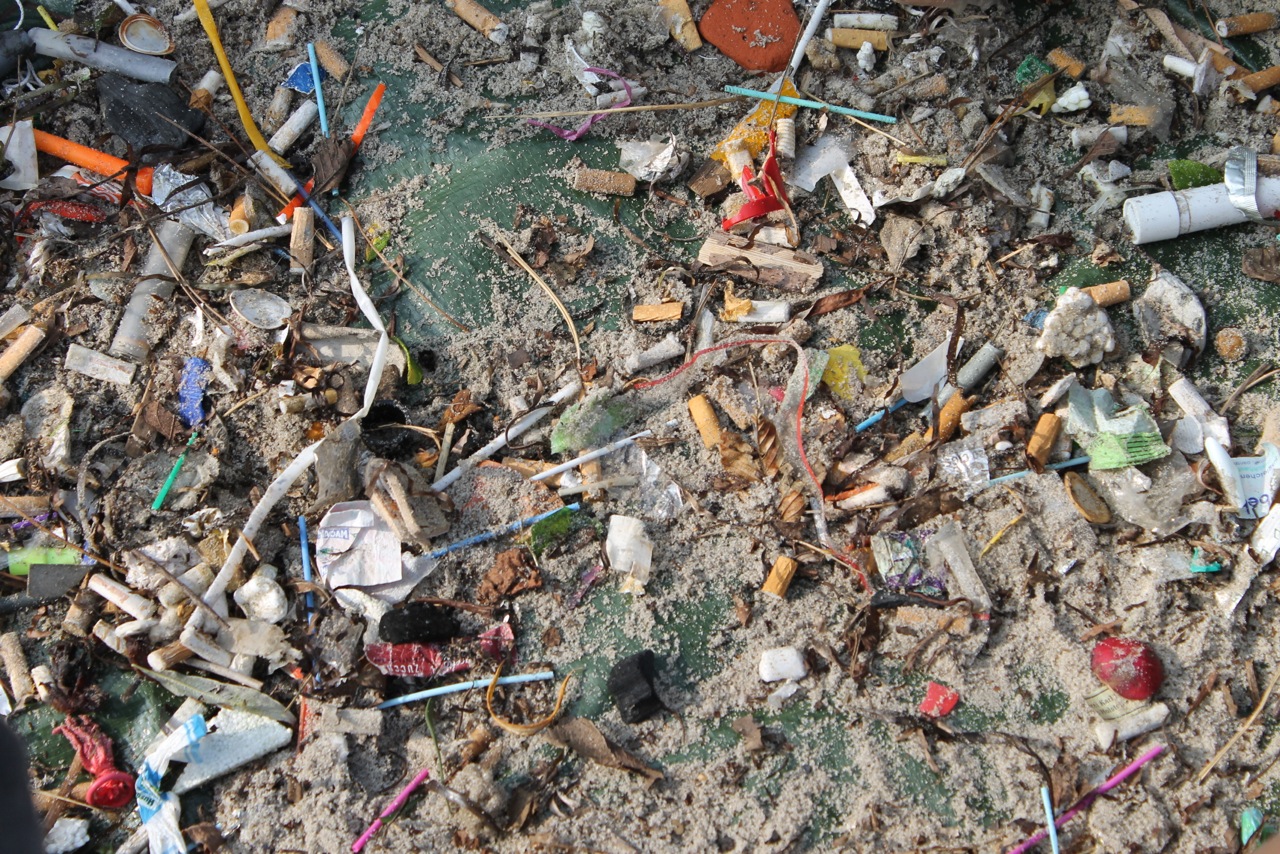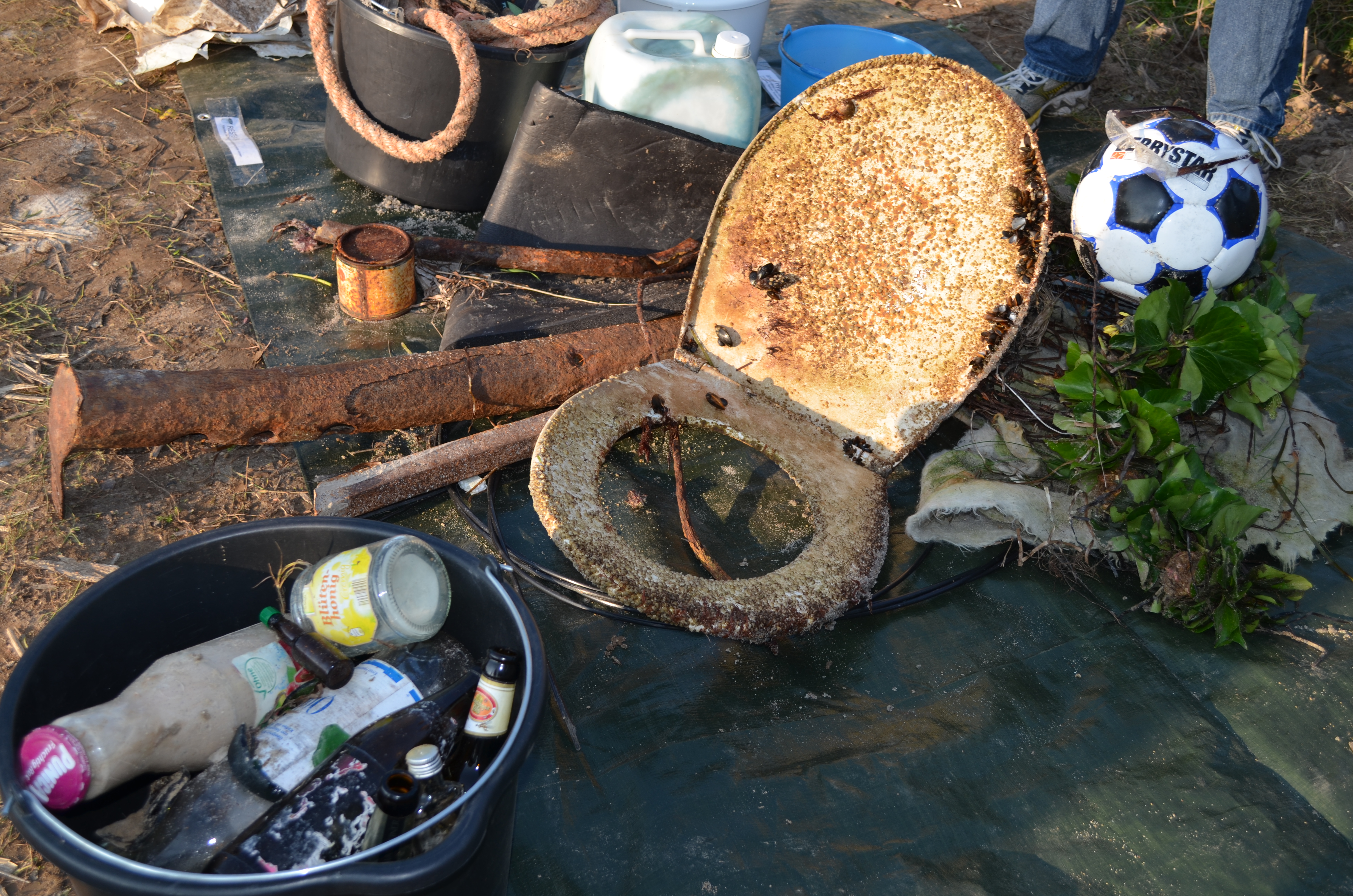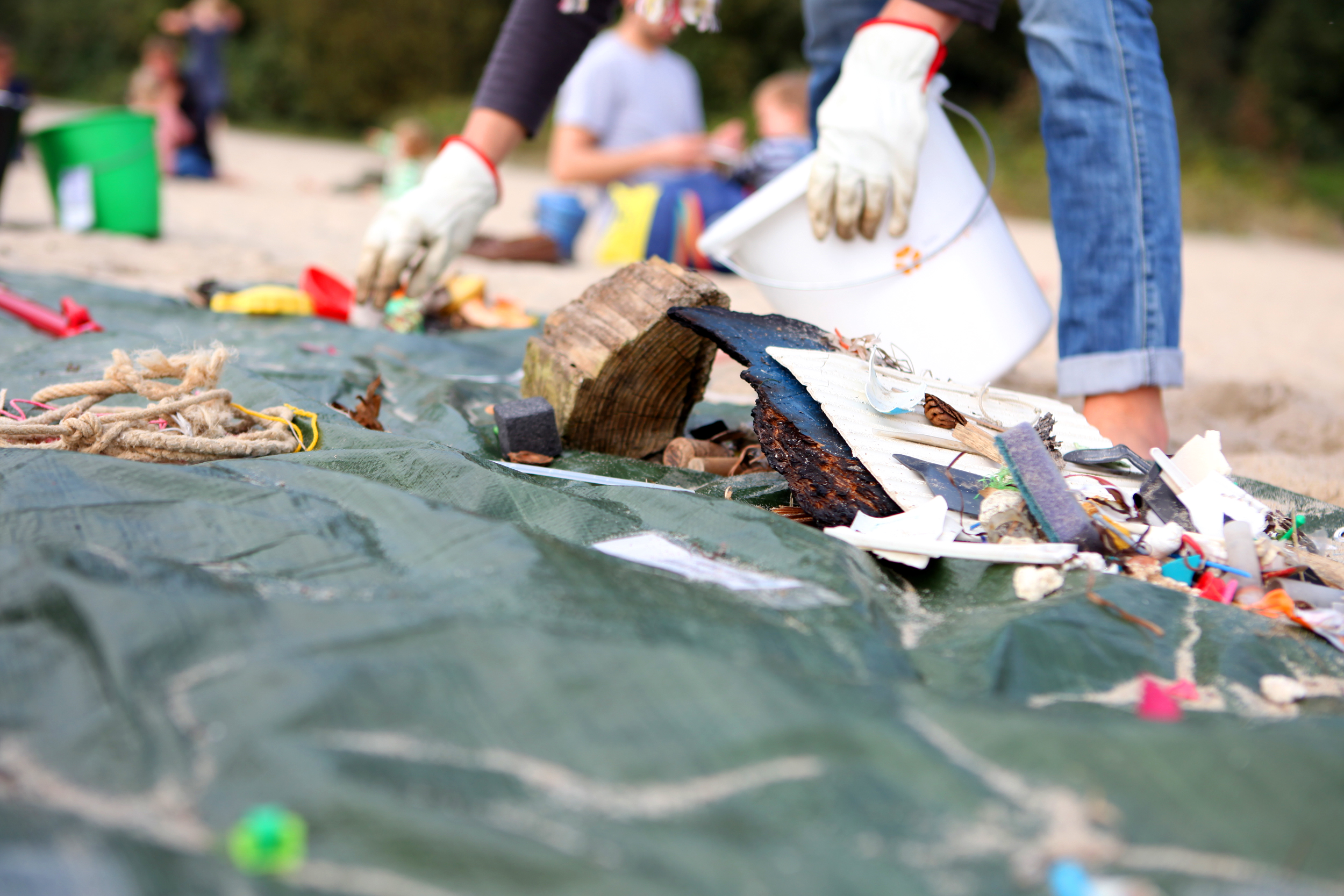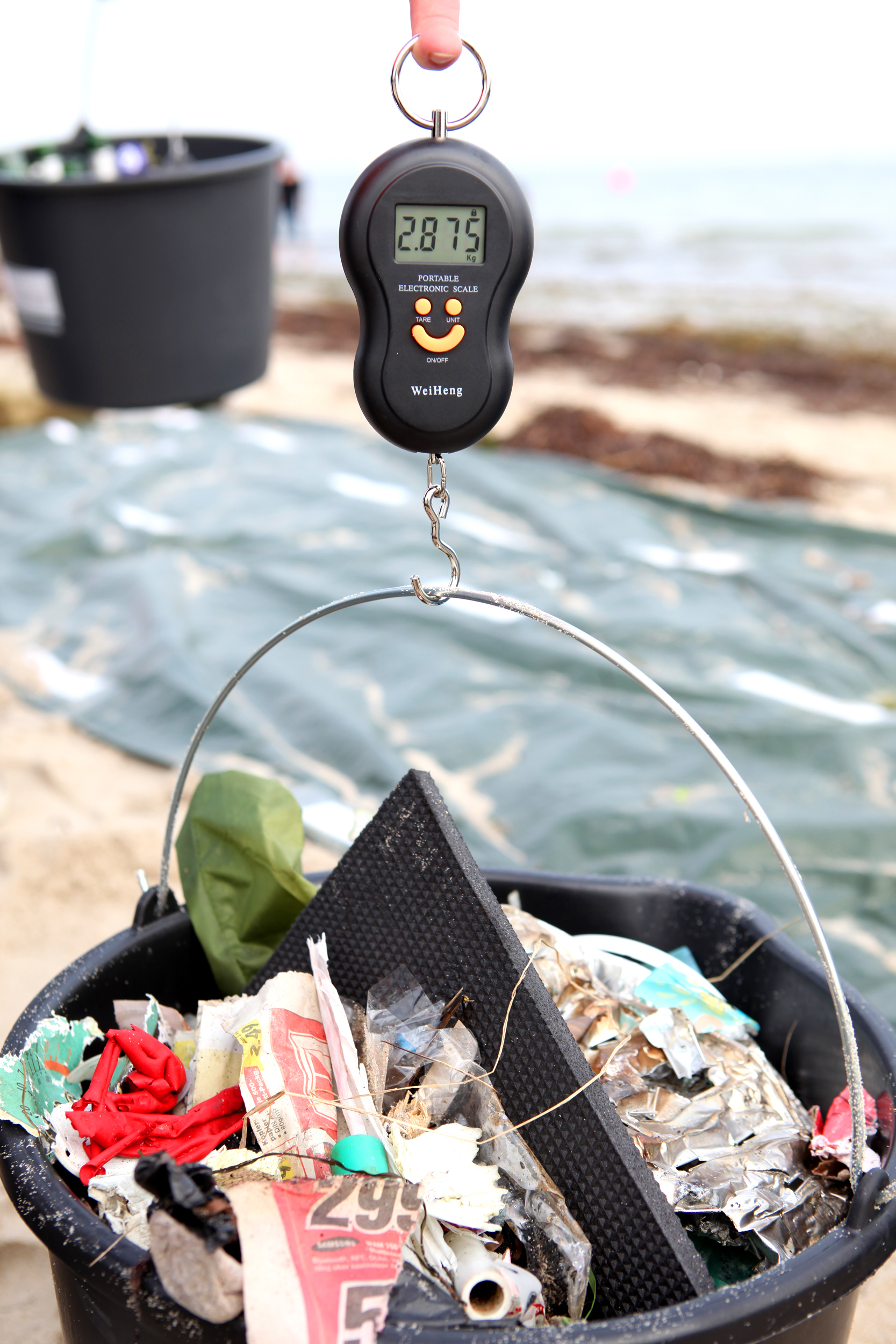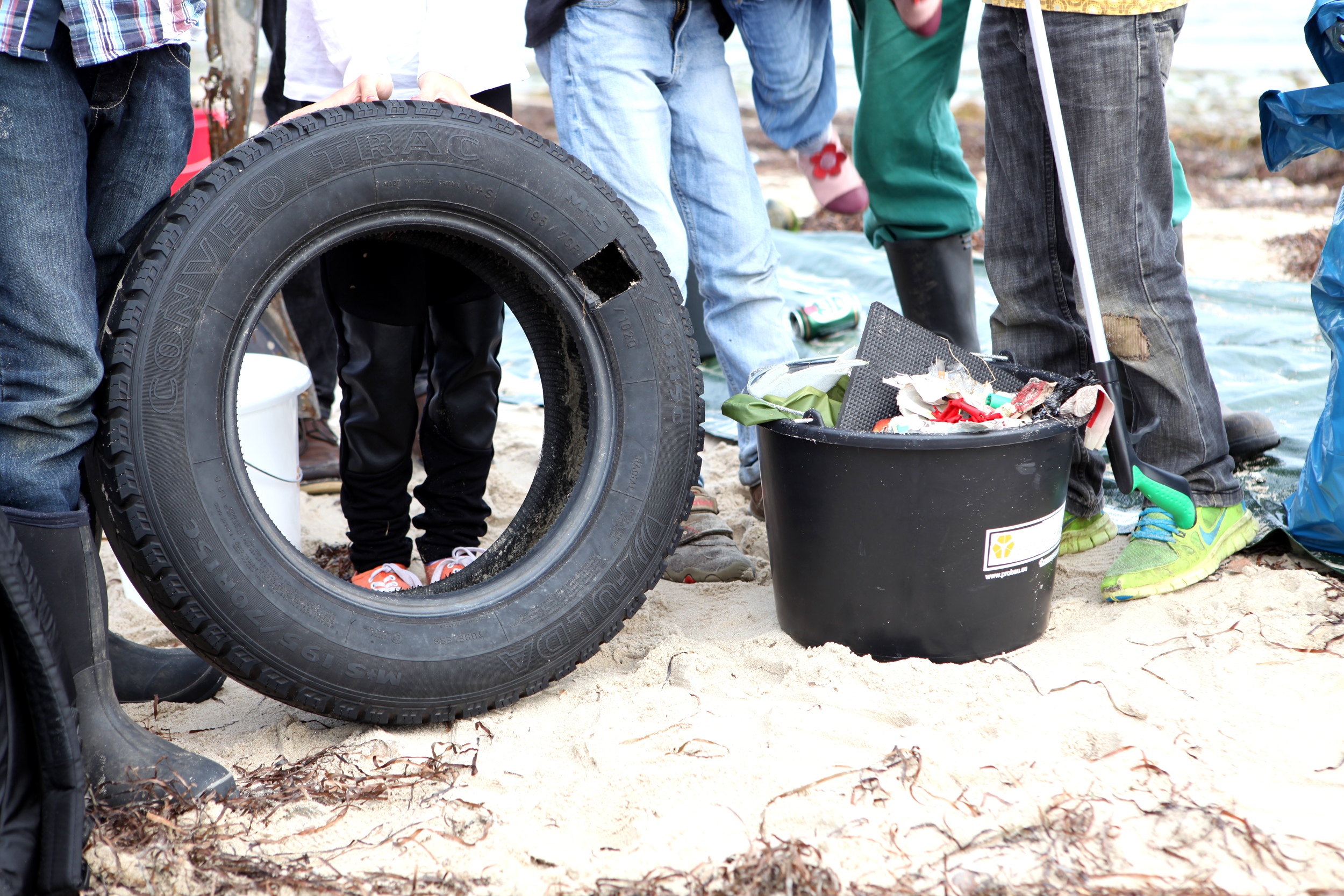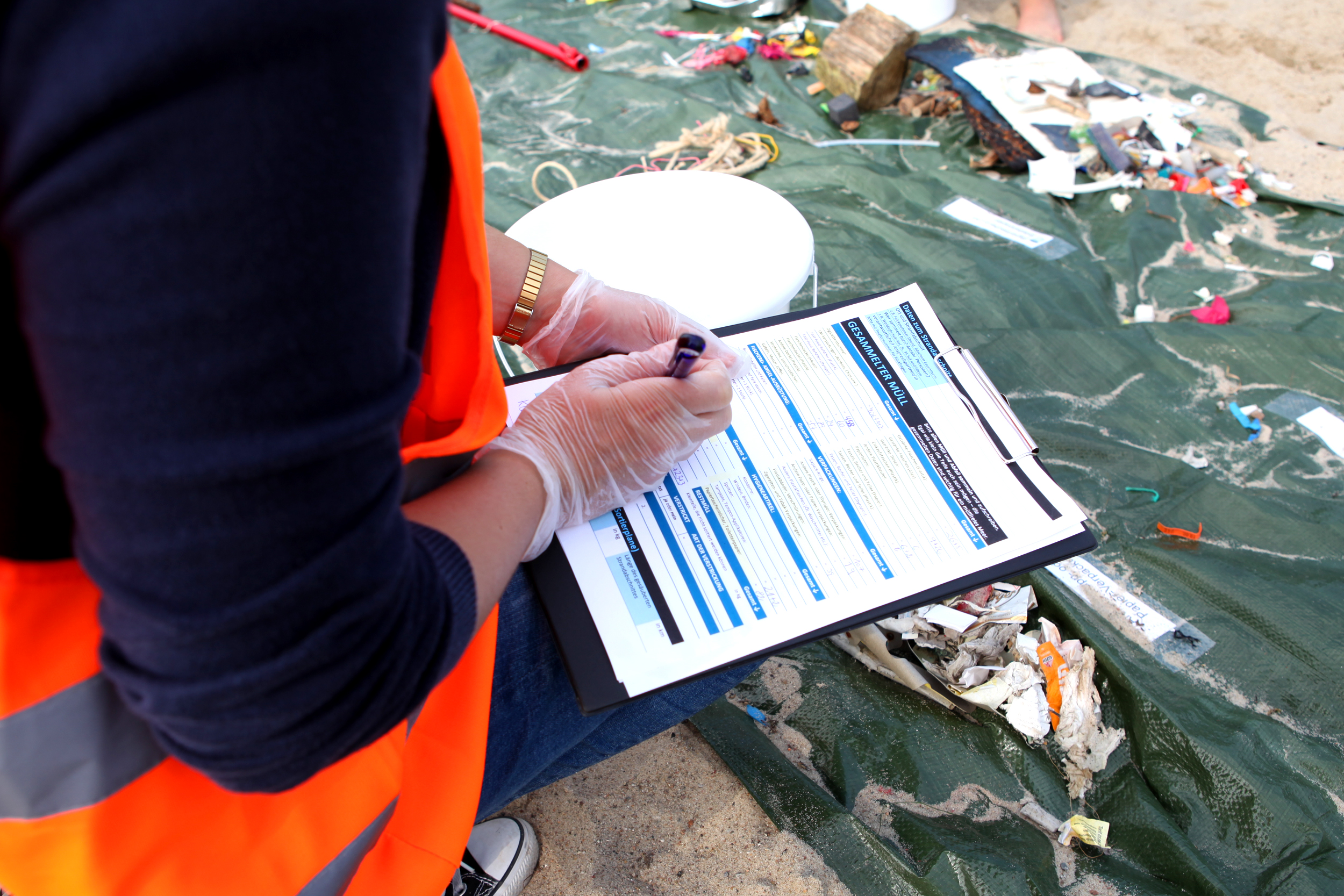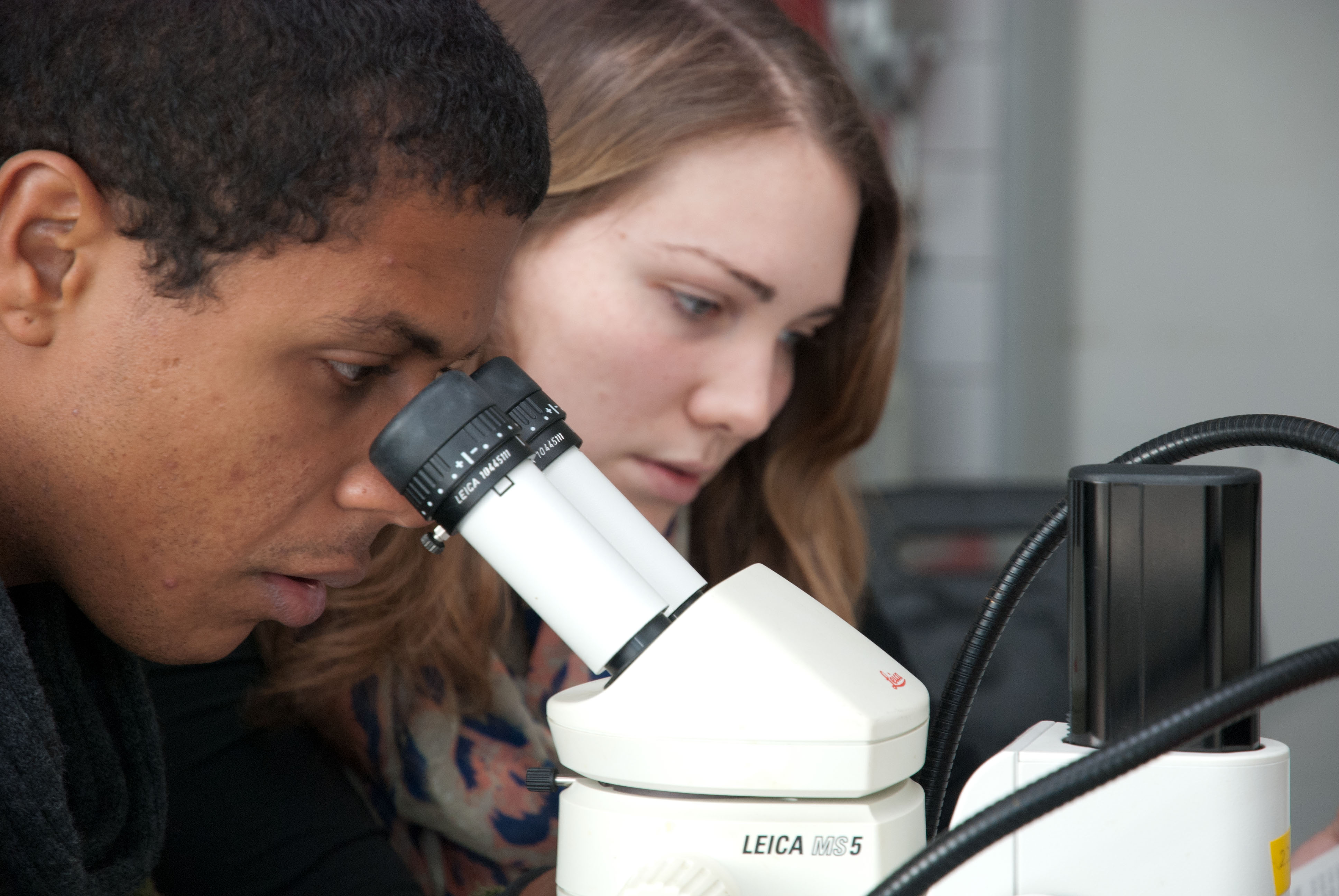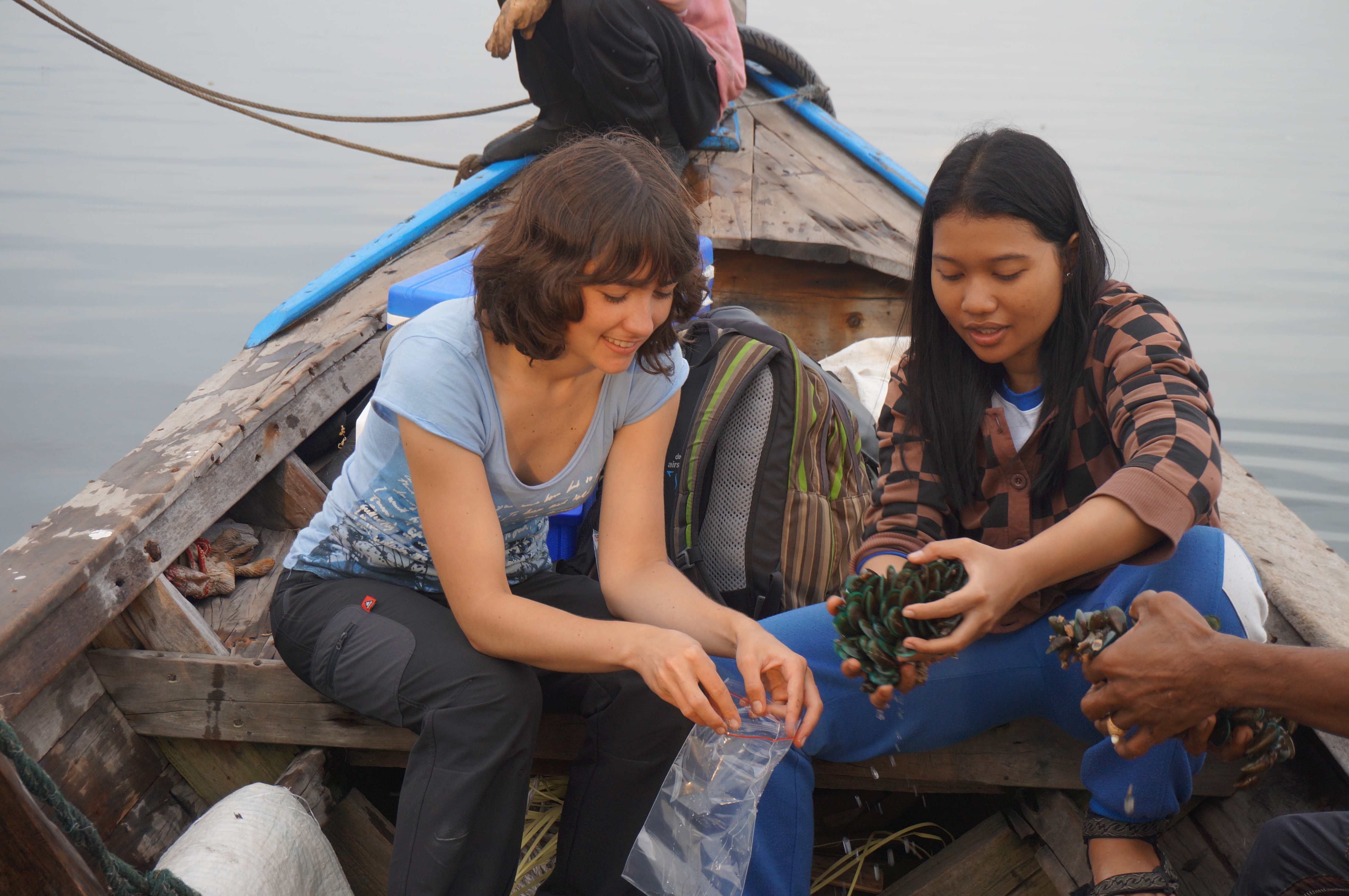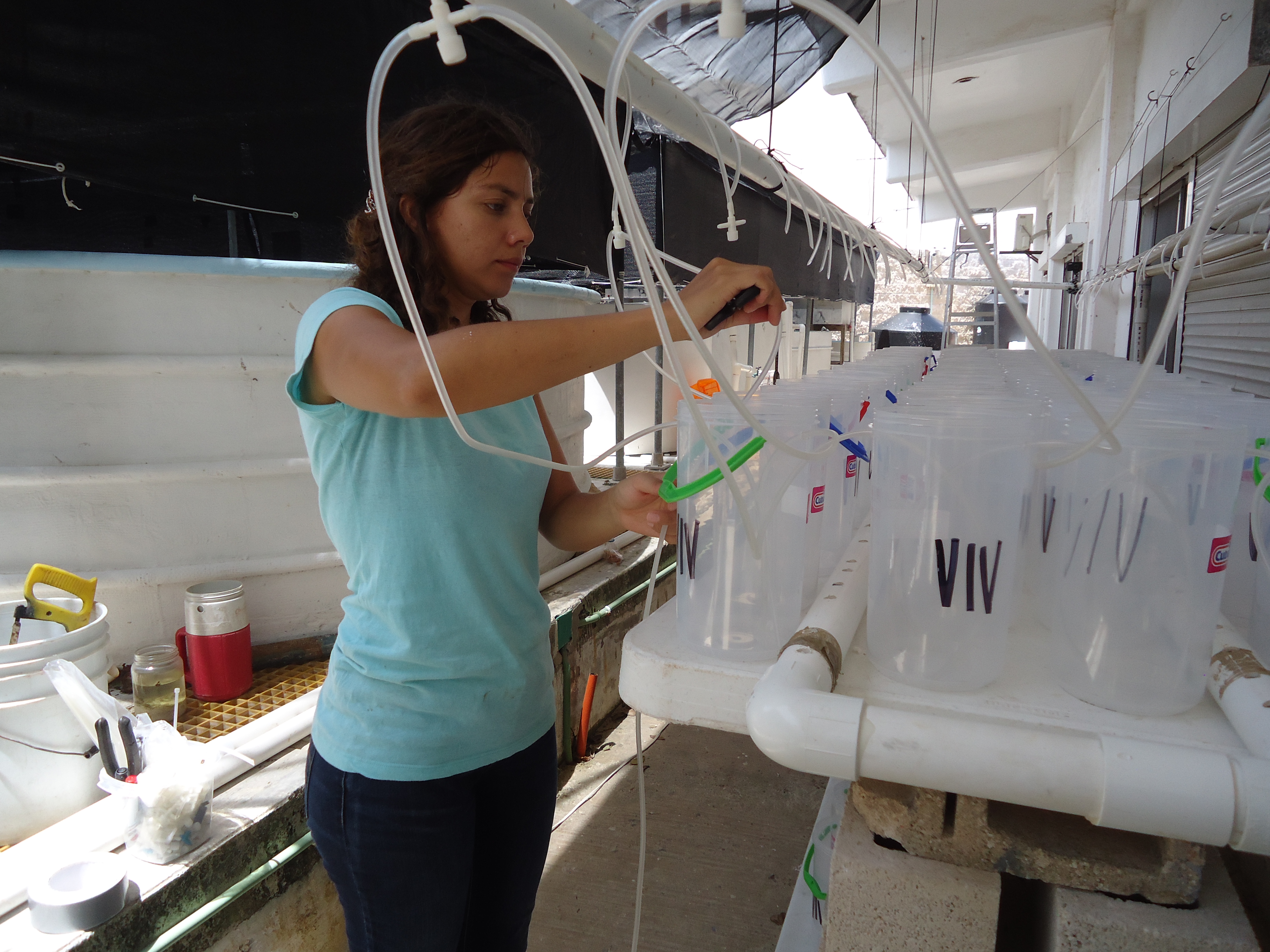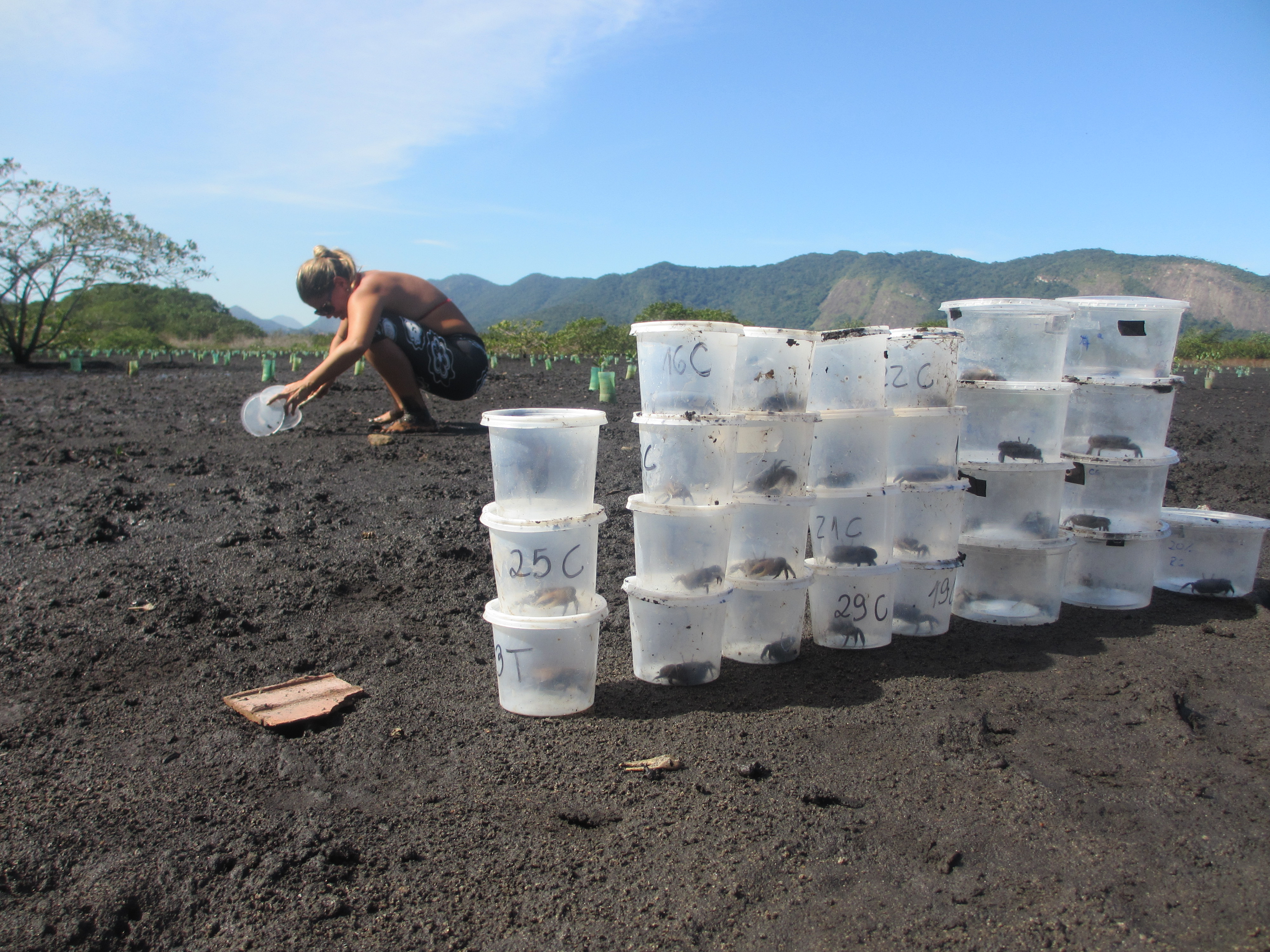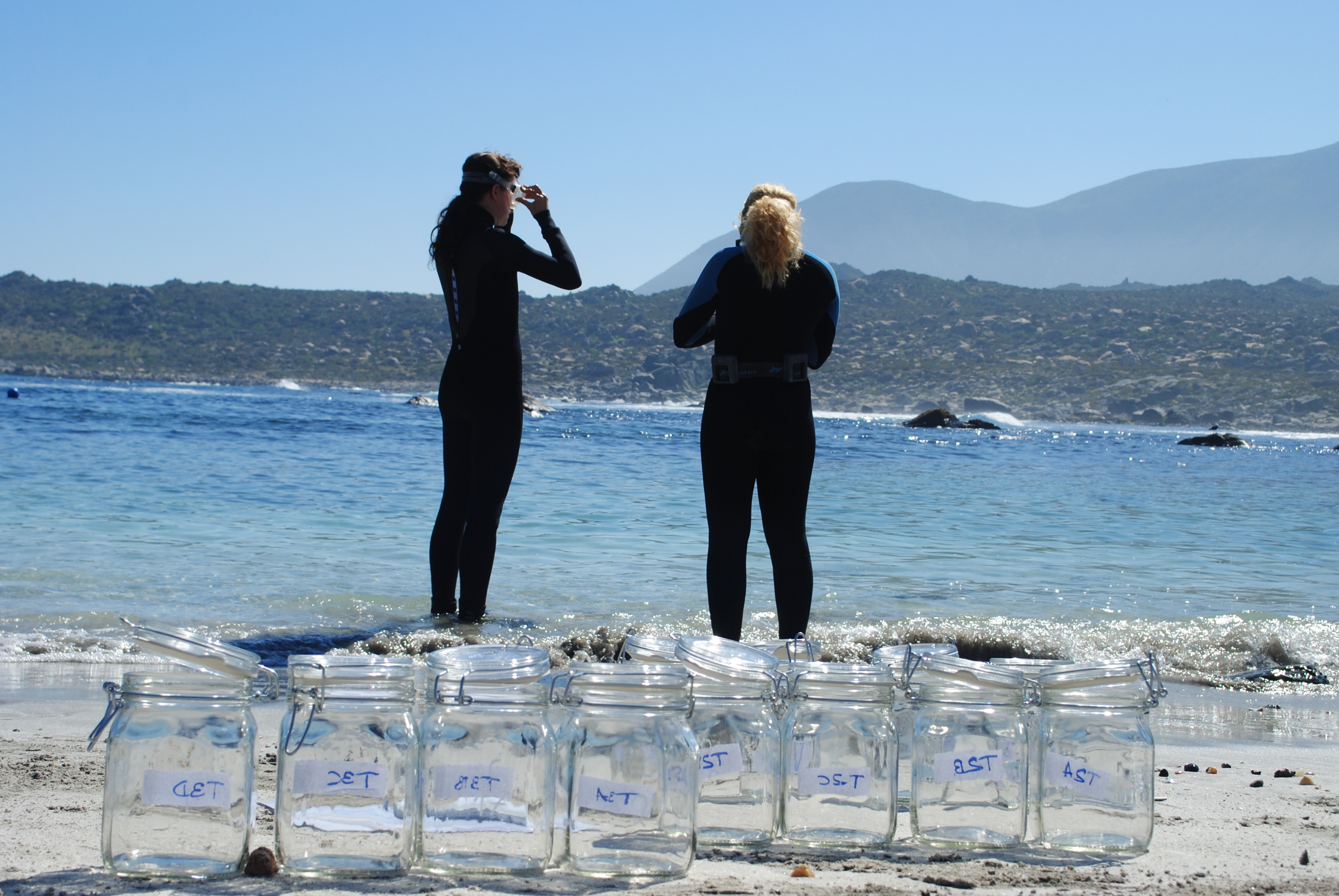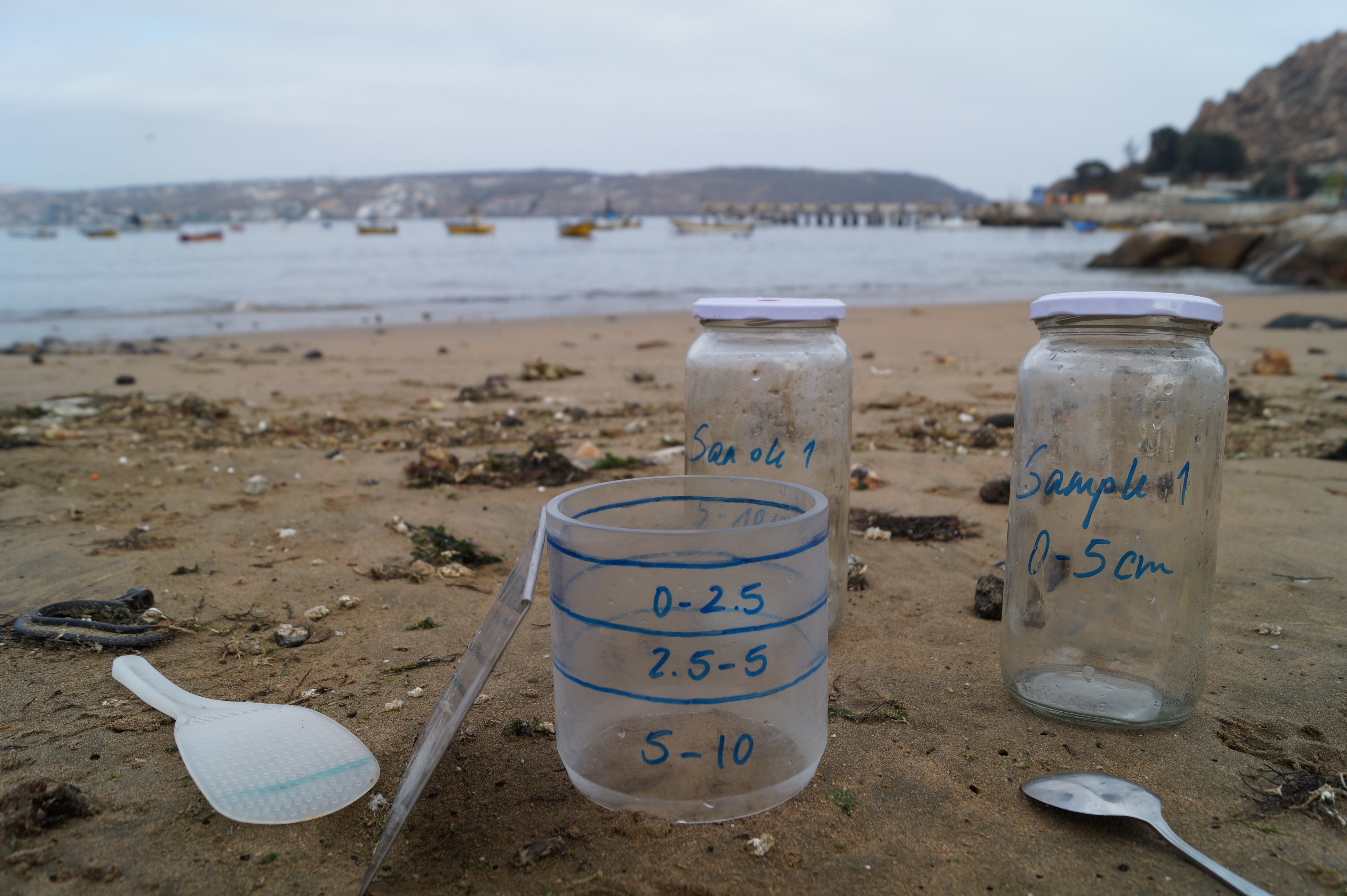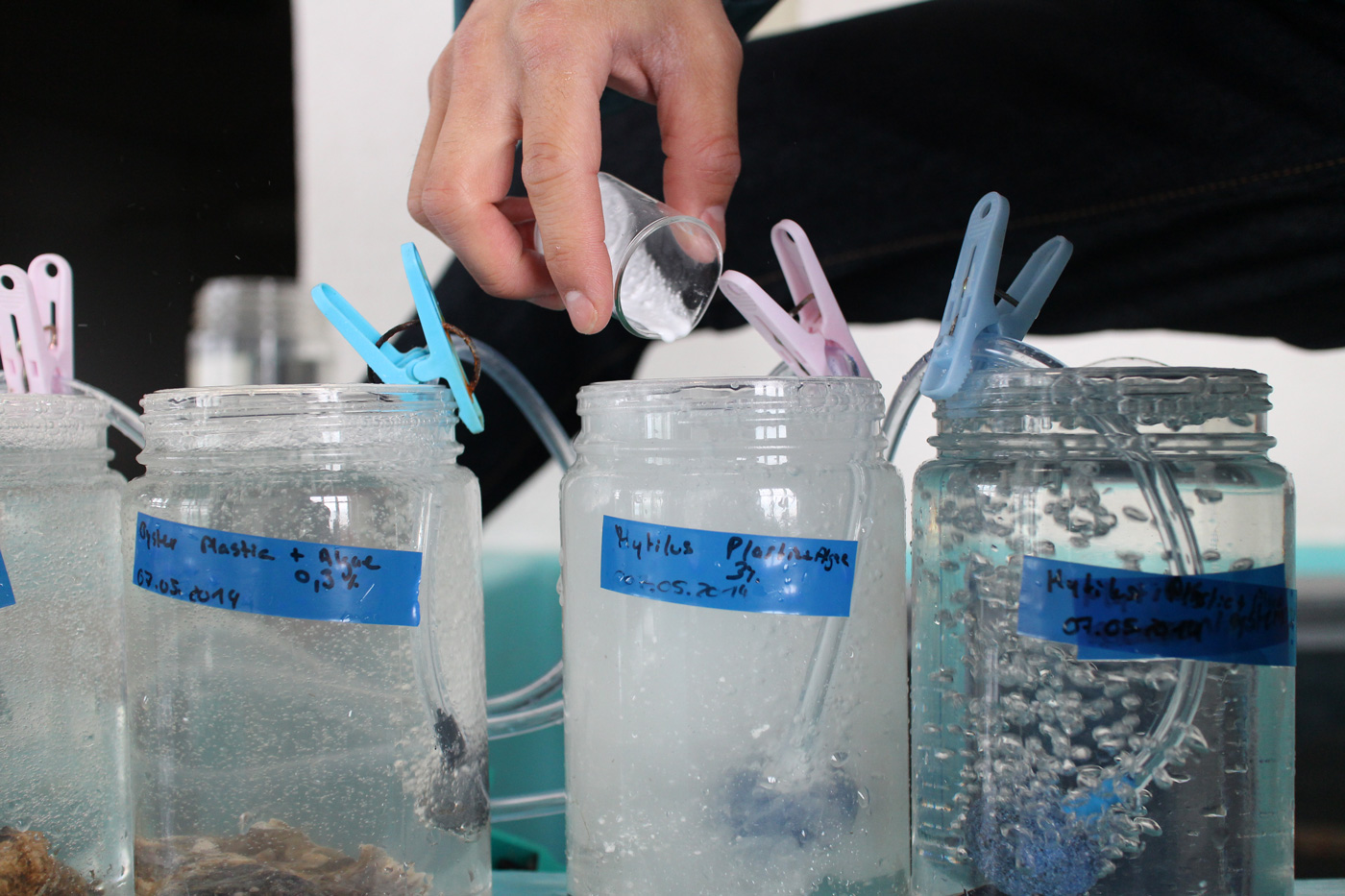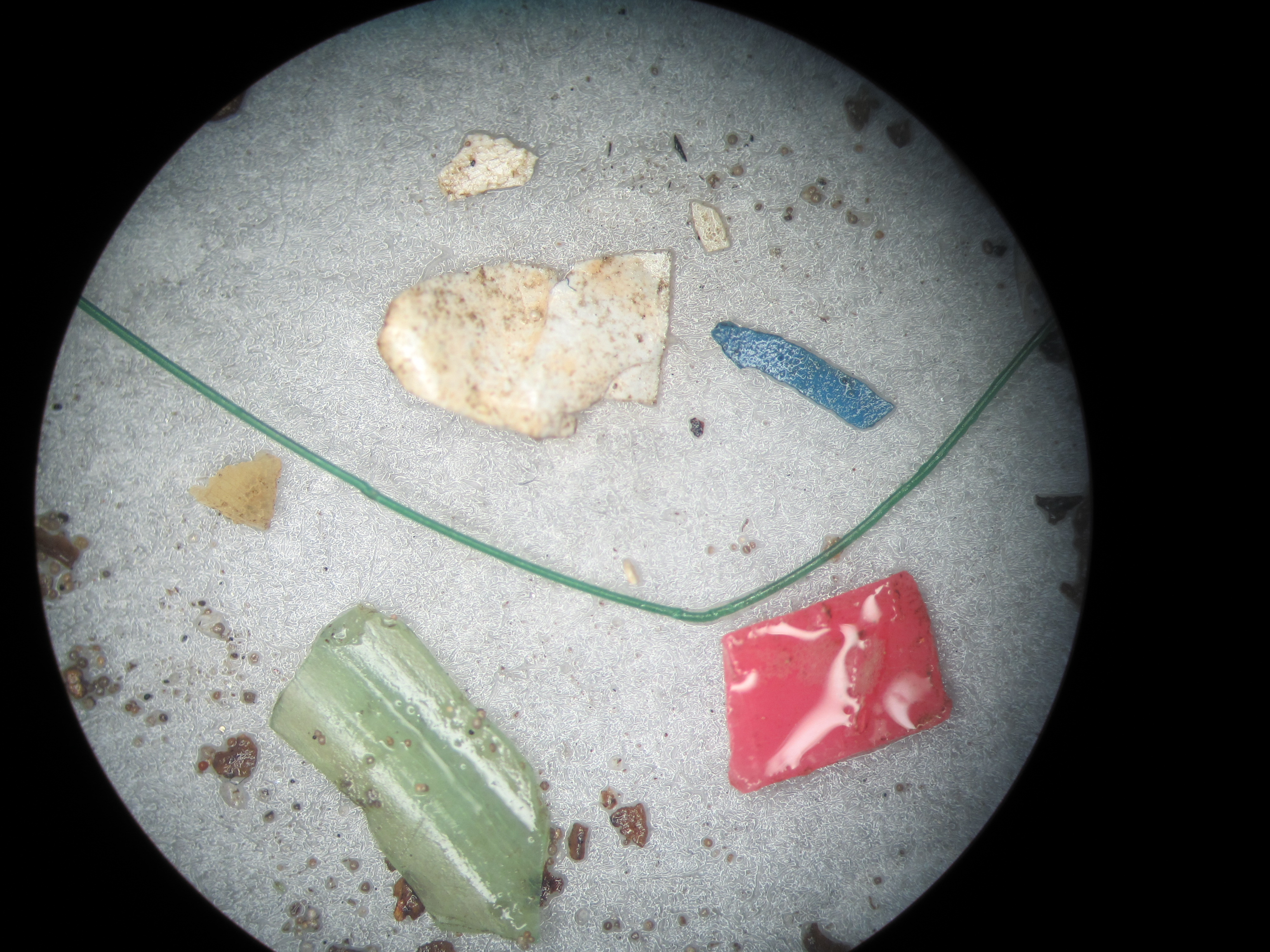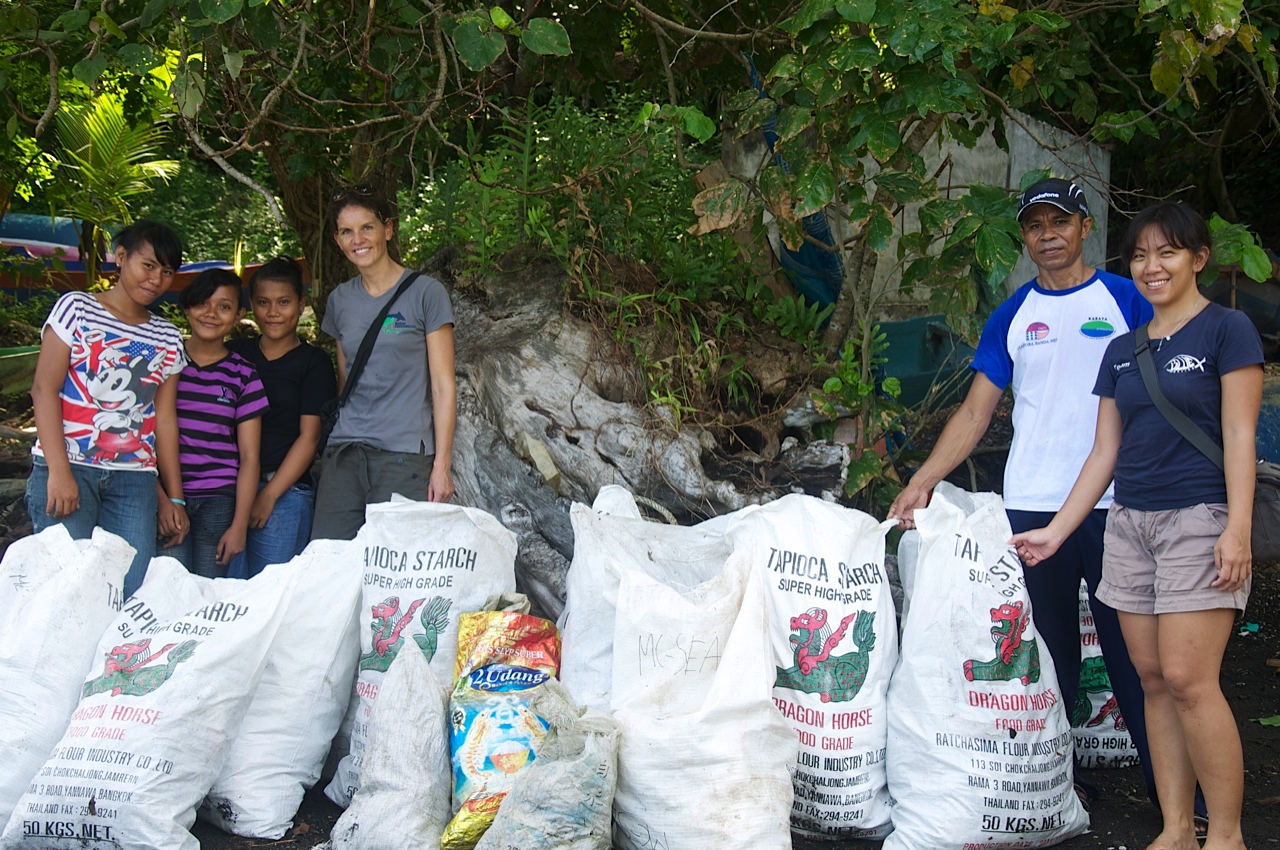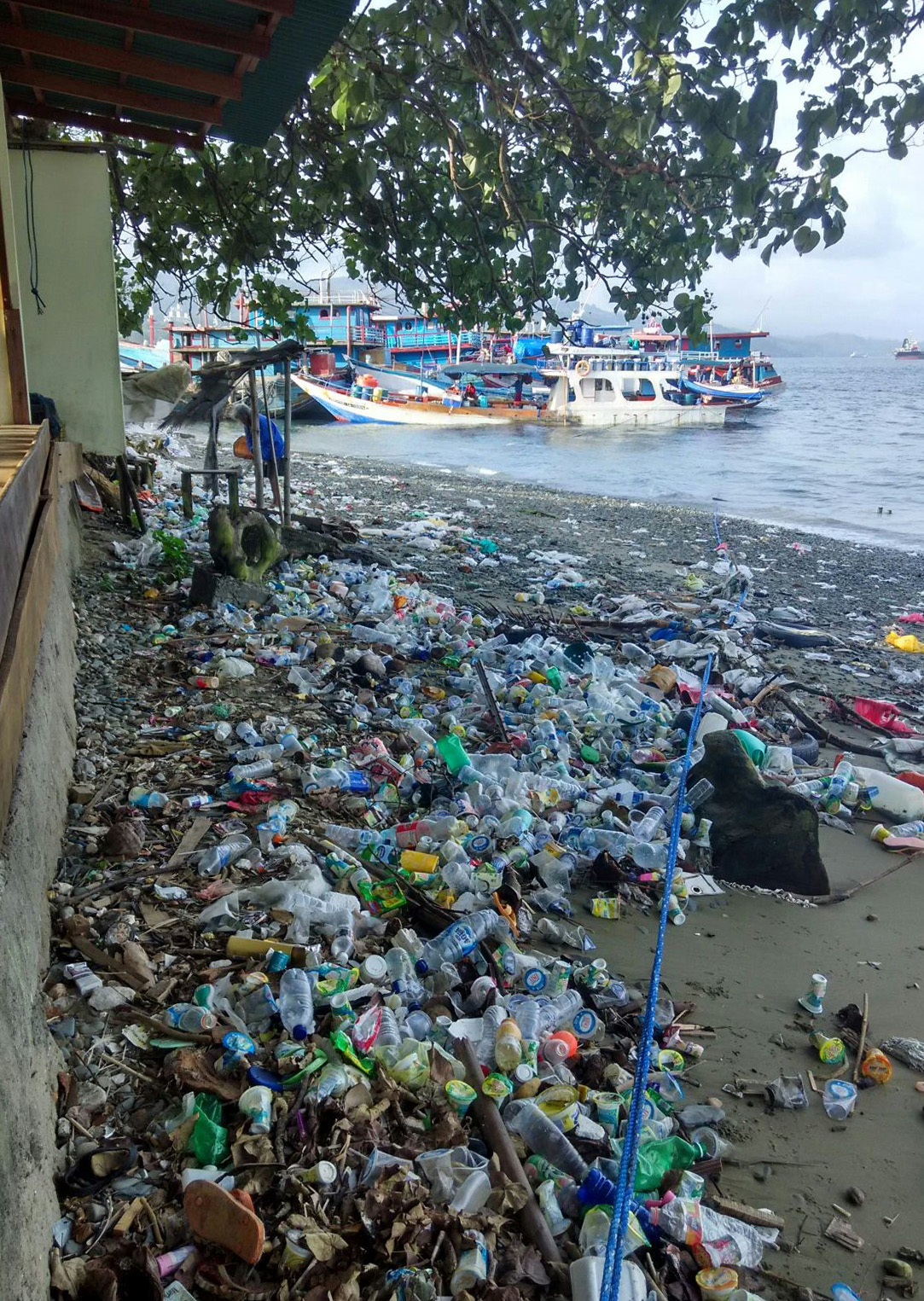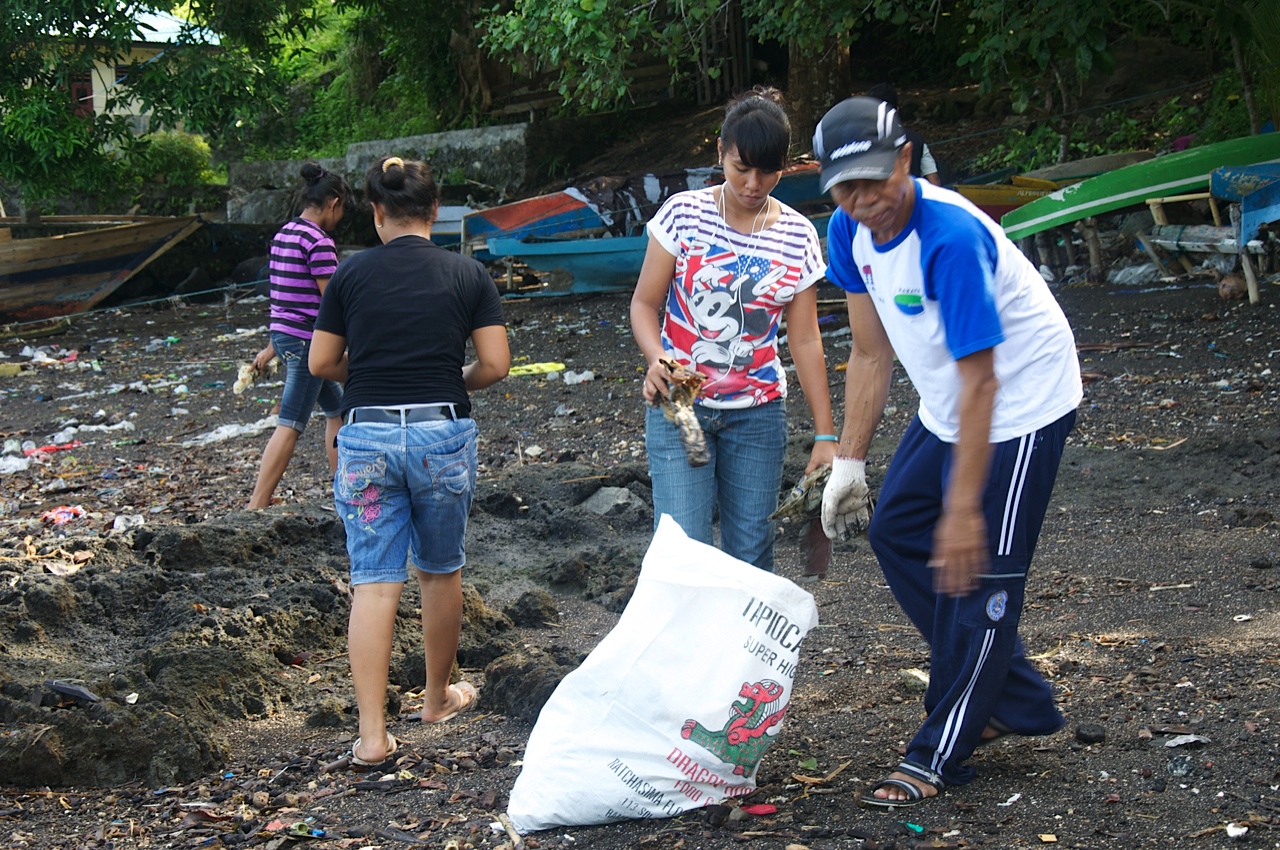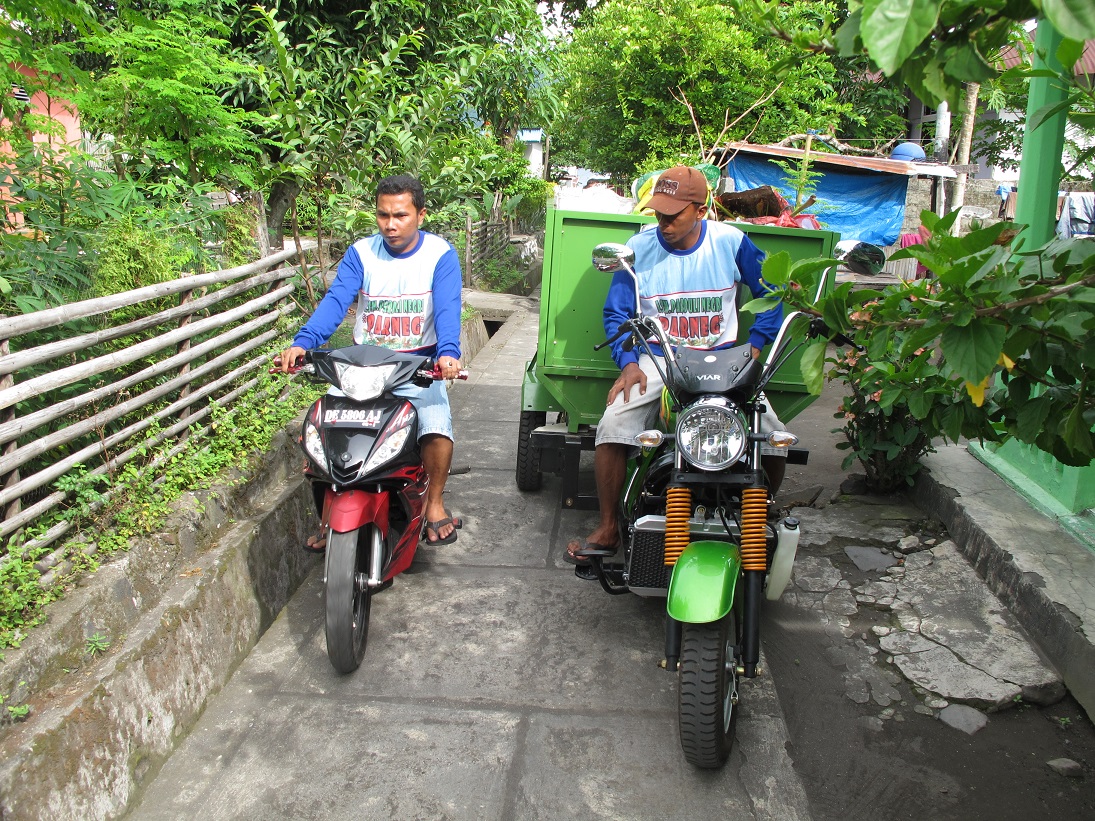Plastic is made up of synthetic organic polymers which are formed through the connection of many smaller molecule components. These polymers are produced from fossil fuels, for example, oil and gas. Plastic is used for many products and has already replaced materials such as paper, glass and wood in many areas. Plastic products are not only inexpensive to produce but they are also quite durable, light and at the same time very stable. But many of these characteristics now constitute a huge problem. Plastic is not easily biodegradable, it accumulates in the environment and often remains there for many decades. Today, huge amounts of plastic float world-wide in our seas, from pole to pole and from the surface of the sea to the deep sea. A majority is floating on the ocean surface and is transported by currents over long distances. Although plastic practically does not decompose, larger parts are broken down into smaller pieces of varying sizes by wind, salt and weather. Those pieces smaller than 5 mm in size are called microplastics. They can hardly be seen with the naked eye. Another characteristic of plastic is the adsorption and accumulation of organic pollutants from the environment and heavy metals to a high degree. Additionally, pollutants such as plasticizers added during plastic production can dissolve in the ocean. Many of the pollutants also have hormonal effects and can even be carcinogenic. Plastic is therefore a mean of transport for pollutants. The size and distribution spectra of plastic is enormous and the degree of damage huge.
Ocean knowledge
Plastic waste in the Ocean
Plastic and its characteristics
Plastic, fish and duck mussels
Photo from Bryce Groark Alamy
How much plastic is in the ocean and how high is the input?
Plastic is everywhere in the oceans and there is always more
Plastic pollution is found everywhere on this planet. Plastic pieces are dispersed by wind and surface currents extensively throughout the world's oceans. According to current estimations, more than 5 billion plastic pieces with a total weight of 268,000 metric tons float here and there in the world's oceans (233,400 tons of macroplastic, 35,540 tons of microplastic). More than 1/3 of this mass can be found in the North Pacific, in particular in the center of the subtropical current. This is the estimation of researchers, who evaluated data from 24 expeditions of over 6 years (2).
The vast majority of plastic floating in the oceans comes in small fragments with a size smaller than 5mm, so-called microplastic (see graph). Most of the microplastic particles are fragments created by the fracture of bigger pieces. In their nets the researchers mainly found different equipment from fisheries which enters the sea directly, such as buoys, lines and nets. But other plastic objects such as buckets, bottles, styrofoam and plastic bags which came from land, were also found (2).
Although reports about plastic waste in the sea already appeared in the early 1970s, more than 40 years later there are still no exact estimations about the amount and origin of the plastic waste which enters the ocean. Now researchers at the University of Georgia have published their calculations about the masses of plastic waste which reach the ocean from land through rivers, sewage, wind and tides. They estimate that in the year 2010 about 2.5 billion tons of litter was created by 6.4 billion people (corresponds to 93% of the world's population), living in 192 coastal states. Approximately 11%, about 275 million tons of this was plastic waste. Roughly 99.5 million tons of this plastic waste can be attributed to the population living within 50 km from the coast. It is estimated that in 2010 4.8 to 12.7 million tons entered the oceans directly from land or from rivers. The largest share of plastic waste entering the ocean in 2010 came from China and Southeast Asia, mainly through inappropriate waste disposal. If the infrastructure of waste disposal remains the same as today, the amount of plastic litter which enters the ocean from land could reach up to 28 million tons in the year 2025. If the 20 countries with the highest waste production would improve their infrastructure, the amount of waste could be reduced by 50% through recycling. For this, major investments in infrastructure for waste disposal would be necessary, in particular in developing countries (3).
Click on the info graph for more details.
Click on the info graph for more details.
How much plastic reaches the ocean through rivers?
For many years the focus was set on coastal regions as the origin of ocean
pollution. But several studies point out that rivers contribute to plastic
pollution more than suspected. Two recent models calculated that rivers are
responsible for a yearly plastic waste input of 2.4 to 2.8 million tones
worldwide (4,5). This equates to up to 22% of land-based plastic pollution and
approximately 67% of plastic river input is transported by rivers in Asia4. More
studies in this area are of great importance as Asian rivers are the most
polluted rivers and they also have the largest fishery (6). But how does plastic
waste and waste in total reach the rivers?
On one hand, micro- and
macroplastics can reach the rivers directly via seawage from waste water
treatment plants for example due to microplastic particles from cosmetics,
clothes and larger hygiene products. On the other hand, garbage ends up in the
river and riversides by leisure activities but also by willful disposal of waste
and household aids. A big issue is the lack of infrastructure when residents
have no access to disposal places and waste water treatment plants, they then
dispose directly into the rivers.
Click on the info graph for more details.
What are the consequences for marine organisms?
Size-spectrum and the distribution of plastic has many impacts
Ocean plastic pollution has different kinds of consequences on marine organisms.
On one hand plastic causes physical stress through entanglement and ingestion
but it also causes threats due to changing habitats and the import of invasive
species. More than 500 species are endangered by entanglement and ingestion of
marine plastic debris. All marine turtle species, 66% of all marine mammal
species and 50% of all sea bird species are affected by plastic
(7).
Entanglement is caused by fishery equipment (so called "ghost nets")
and other waste. Most affected are marine mammals, predators preying on fish
hiding in marine debris, sea birds using nets for their nests, but also crabs,
octopus, sponges, gorgonians and corals can be harmed by fishing lines and other
equipment. This can reduce the animal's food intake and therefore lead to
starvation. Marine mammals can drown and be injured when entangled in
nets.
The settlement of plastic material on the ocean floor can have
enormous consequences. Ecosystems of seagrass meadows, coral reefs, mangrove
forests and intertidal zones can be impacted by the reduced sun light exposure
and photosynthesis rate as well as reduction of water exchange. This can lead to
less nutrients and oxygen in the direct environment, which has severe impacts on
organisms living at the sea floor.
The oral intake of plastic by marine
animals happens conscious or unconscious. The conscious intake of plastic is
mostly due to simple confusion when plastic has a similar color and shape as the
hunted prey. Unconscious intake of plastic happens mostly to filter feeders,
such as small crustaceans, fish, baleen whales and worms. They filter the water
as a mechanism of foraging and therefore also take in the plastic particles.
Plastic can also be taken up, for example when the prey is contaminated with
plastic and eaten by another. This has already been shown in laboratory studies
and nature. The intake of plastic can harm the digestive tract or block it up
leading to starvation.
A much larger threat is posed by plasticizers and
organic pollutants. Plasticizers are processed during the production of plastic
and gives it its special qualities (e.g elasticity, durability). They are not in
a strong chemical bond with the plastic and easily soluble. Plastic also has the
chemical property of adsorbing organic pollutants from the environment in large
quantities. If plastic is now taken in by marine animals, the pollutants and
plasticizers will enter the organism and can cause cancer, reduce fertility and
weaken the immune system.
Another property of plastic is, that it floats on
the ocean surface. Over time, the plastic surface will be populated by sessile
animals. But also motile animals will look for protection in the flotsam. Wind
and currents will carry the floating habitats into other ecosystems, in which
the travelled species could drive away native species. This can cause extreme
changes within the ecosystem and the entire food chain could be altered. The
increasing pollution with plastic and the durability of it (in comparison with
organic flotsam) give rise to the idea, that the spreading of species will go
up.
How does plastic enter the human body and what are the consequences?
The uptake pathways and possible consequences
Plastic in the environment not only appears on microscale but also on nanoscale
due to ongoing degradation of microplastic (secondary microplastic) but also due
to direct production for example for paints or 3D printer (primary
microplastic).
For many years', studies focused on the consequences of
plastic uptake by marine organisms but recently the interest on the effects of
plastic and its toxicity in the human body rose.
There are two pathways how
micro- and nanoplastic can enter the human body: ingestion and inhalation. Many
marine species ingest plastic particles, which then accumulate in the digestive
tract but also in other organs and cells. Several marine animals are an
important food source for humans such as fish and shell fish. It has been
estimated that a regular uptake of European mussels can lead to a plastic uptake
of approximately 11,000 particles each year (10). However, the actual plastic
ingestion through marine animals and the resulting consequences are unknown.
Micro- and nanoplastic has also been discovered in following food and beverages:
honey, sugar, sea salt, beer and tap water.
The second pathway is the
inhalation of with plastic contaminated air. Plastic particles can reach the
atmosphere for example due to clothes (fibers from e.g. polyester and
polyacrylic) and abrasion of car tires. Furthermore, sludge from waste water
treatment plants is used as fertilizer on agriculture land. It has been
investigated that the sludge contains textile fibers which are released into the
air after drying. A study measured the microplastic abundance in Paris in
densely populated areas and less populated areas. On average, 110 +- 96
particles/m2/day were measured, predominately fibers. Moreover, the particle
density was higher in the city than in the suburb, which lets one assume that
the inhalation of plastic is higher in the city (11).
Plastic is very
resistant towards chemical degradation. Therefore, it is unknown whether
ingested or inhaled plastic particles also resist mechanical clearance of the
gastrointestinal tract or lung. A small particle size (e.g. <1um) increases
the possibility of cell uptake and the transport via blood to other organs. But
retention time, uptake and clearance of microplastic does not only depend on
particle size, it also depends on the structure, solubility and the surface
chemistry of the particle. Furthermore, the anatomical structure of where the
particle was deposited and its interactions is of great importance for further
processes. With plastic uptake, attached additives and adsorbed organic
pollutants can leach into the human body. Organic pollutants leach 30 times
faster from plastic particles in a simulated digestive environment (38°C, pH 4)
than in sea water (12). This can have serious consequences as organic pollutants
can be carcinogenic and also negatively influence the immune system. Additives
are also known to have a negative impact on human fertility. Another danger
could be the transport of pathogenic bacteria on the plastic surface which then
reach the human body. Plastic in the environment, is colonized by microorganisms
(such as bacteria and fungi) immediately and a so called "biofilm" is formed on
the surface. Pathogenic bacteria such as Vibrio species, have already been
discovered on plastic surfaces (13).
Click on the info graph for more details.
Us in Kiel: School lab and research
In the ocean:lab of the Kiel Science Factory (Kieler Forschungswerkstatt), a set
of laboratories at Kiel University open to school classes, the topic "waste in
the ocean" is always included in one research day. With small experiments and
tasks, the students learn what plastic is, how plastic waste enters the ocean
and how long it takes for plastic waste to decompose in the ocean. Moreover,
they carry out experiments concerning the characteristics of different plastic
types and filter microplastic from cosmetic products and sediment samples. The
ocean:lab is focused on students from the third to the sixth grade and eleventh
to the thirteenth grade. The course material is adapted to their state of
knowledge in order to provide fascinating insights into marine science and the
working methods of scientists. Not only do students learn about marine life they
also explore the danger of human interference with the ocean.
For more
interested groups, a new course has been introduced where students learn about
plastic and its threats for a whole day. The "Plastic-Day" is addressed to
students from the seventh to the tenth grade. Within six hours, the participants
work intensively on the following topics: "Microplastic – tiny particles huge
problem", "Bioplastics – a potential alternative?" and "Plastic recycling – a
second chance for resources". Additionally, they are asked to produce a
stop-motion film concerning the topic and with it, explore how social media can
help reaching the general public.
In addition to the program for school classes, the Kiel Science Factory (Kieler
Forschungswerkstatt) coordinates the Coastal Cleanup Day along the Kiel Fjord
each year since 2013. This internationally conducted program, was initiated by
the Ocean Conservancy in order to draw attention to the littering of our oceans
all over the world. On the Coastal Cleanup Day in 2013, about 125kg of waste was
collected along a section of 3 km beach in Kiel. Afterwards the collected waste
was sorted, counted, weighed and reported to the world-wide database of the
Ocean Conservancy by 100 volunteers, in particular school classes. In 2014 an
increased stretch of 13.5 km of shoreline was liberated from waste with the help
of 503 volunteers from schools and associations. With 423 kg waste, including
more than 33 000 cigarette butts, the yield from 2013 was exceeded by far. The
collection balance was outnumbered again in the year 2015 when 554 volunteers
freed 21.8 km of beach in the Kiel Bay from 658 kg of waste. Within the years,
not only the beaches along the Kiel Fjord were cleared from waste, also parts of
the North Sea and inland waters in the area.
In 2016, 776 volunteers
cleared in total 17.5 km of coastline and collected 578 kg of garbage. On
average, 307 garbage items were collected every 100 meters. In the following
year, 723 kg of waste from 18.9 km beach were disposed by 658 participants. In
2018, a new record with more than 1000 volunteers was reached and in total 1813
kg of waste were removed from 25 km of beach, this time with the help of divers
from under water as well.
Overview Coastal Cleanup Day,
Results (focus on Kiel Fjord but also waters
in the area)
2013: 100 volunteers, 115 kg waste, 3 km beach
2014: 500
volunteers, 423 kg waste, 13 km beach
2015: 554 volunteers, 659 kg waste,
22 km beach
2016: 776 volunteers, 578 kg waste, 17,5 km beach
2017:
658 volunteers, 723 kg waste, 18,9 km beach
2018: 1083 volunteers, 1813 kg
waste, 25 km beach
Plastikpiraten - Kiel Science Factory
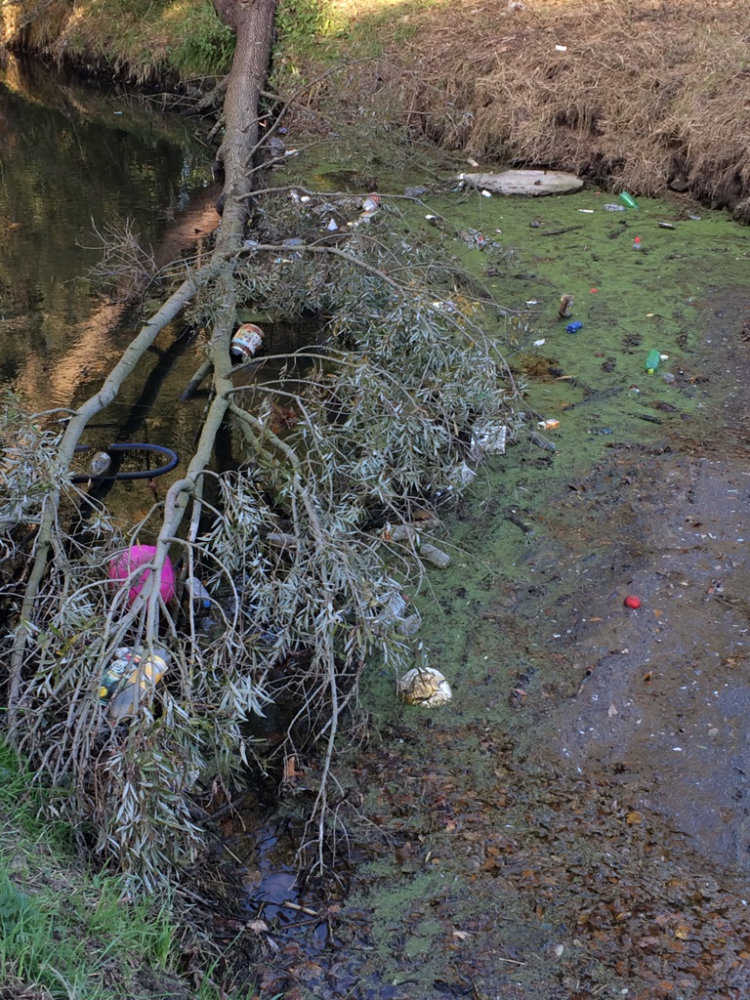
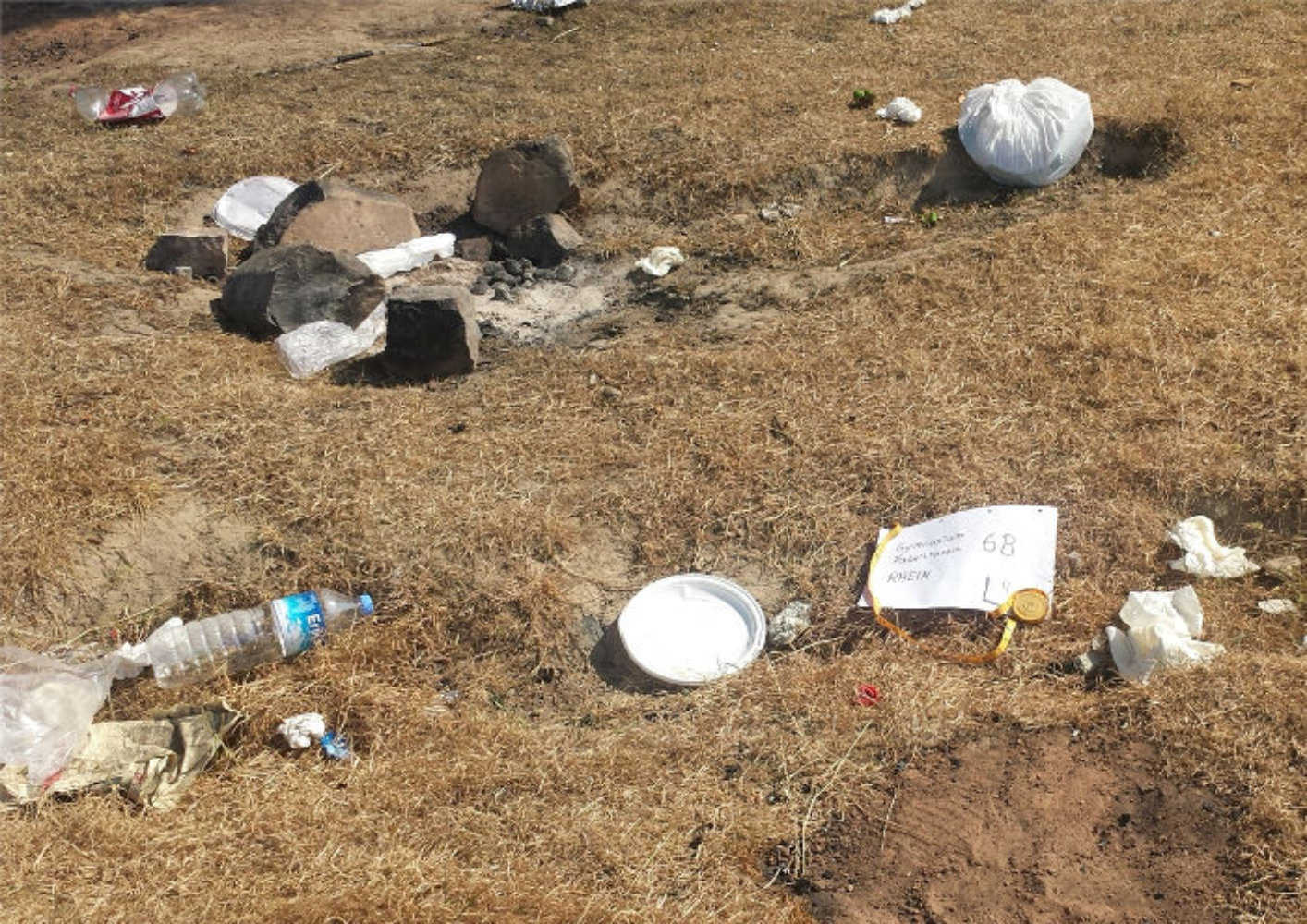
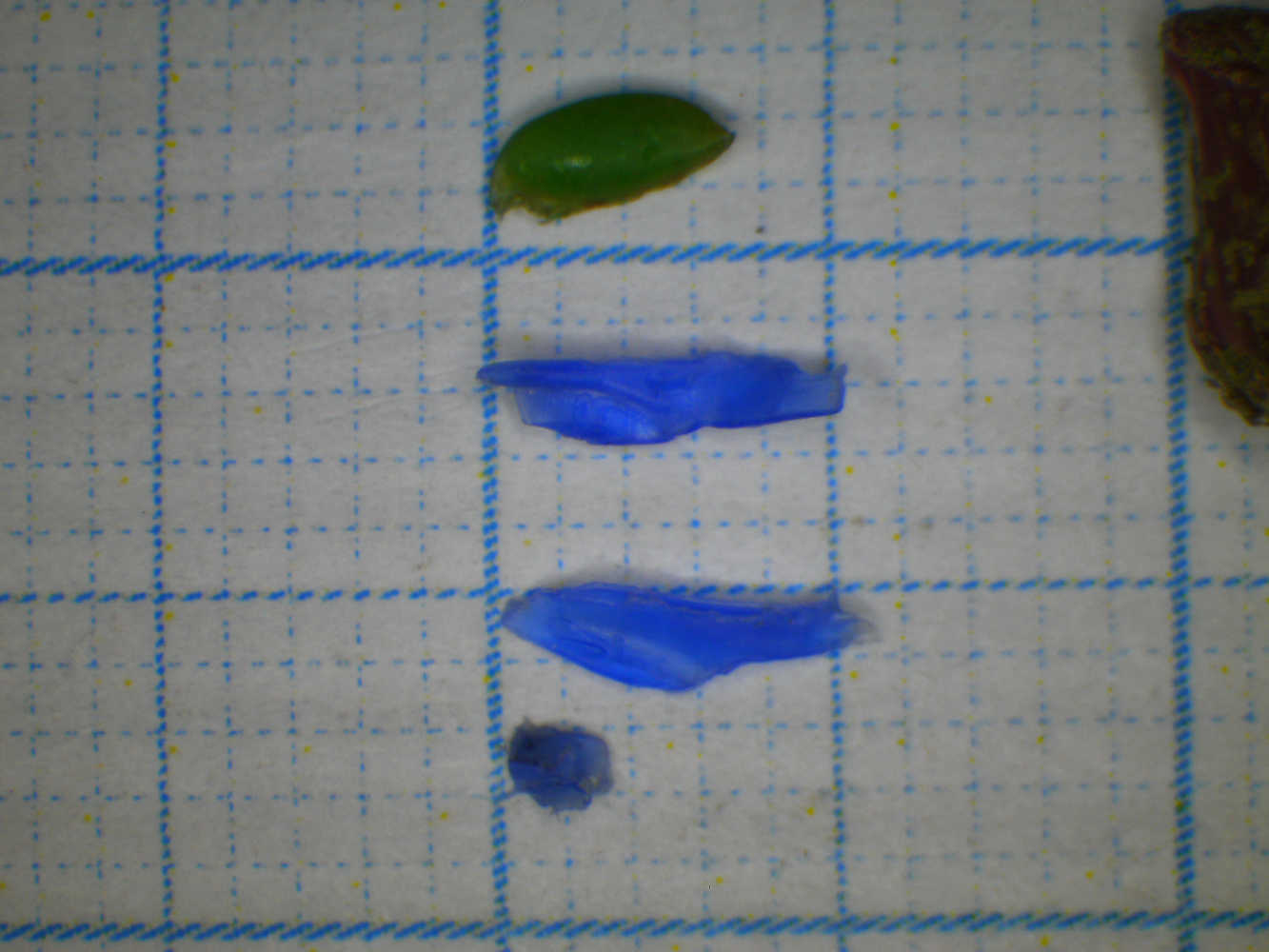
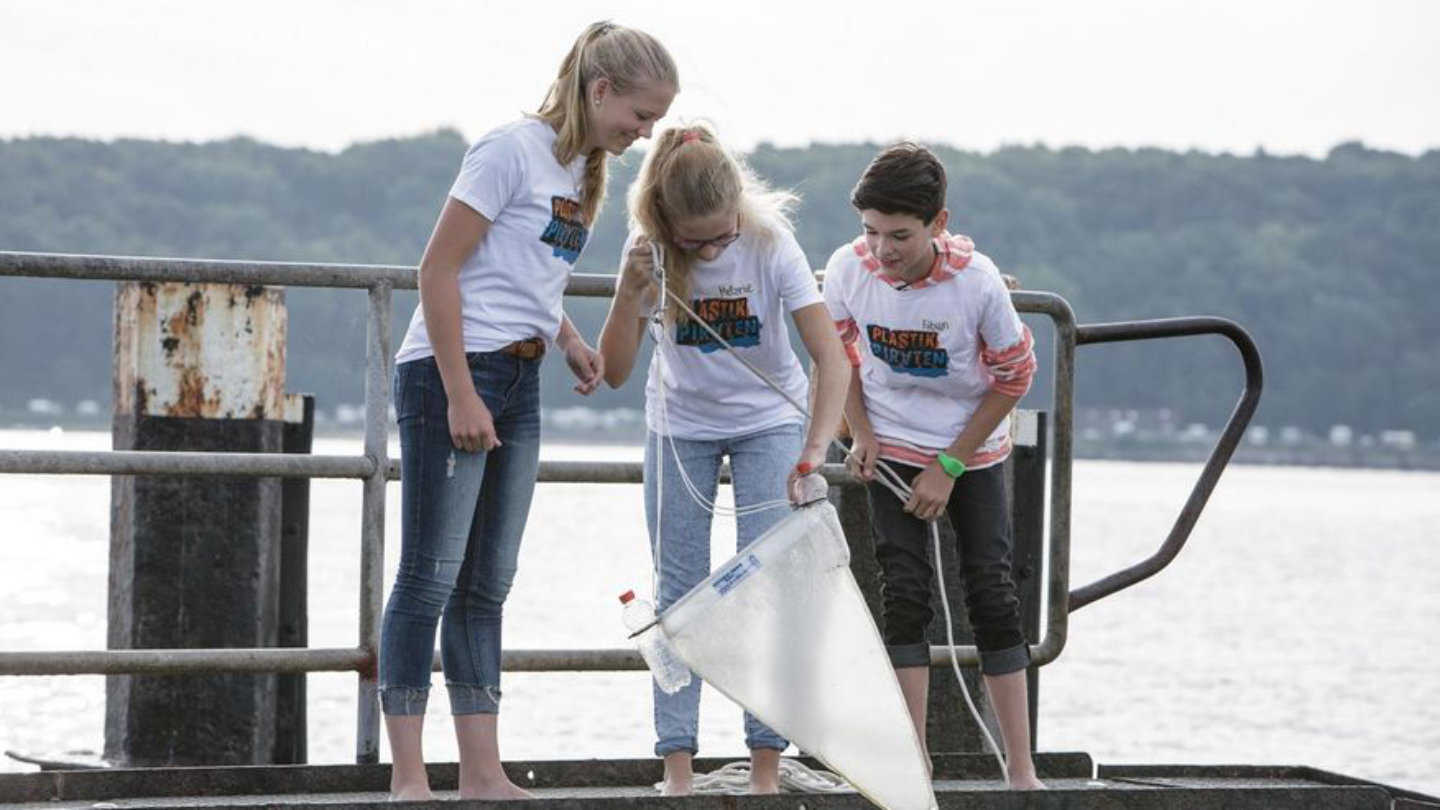 1. Photo: Werner-von-Siemens Gymnasium Gronau, 2. Photo: Gymnasium Fabritianum
Krefeld, 3. Photo: Kieler Forschungswerkstatt, 4. Photo: BMBF Wissenschaftsjahr
2016*17
1. Photo: Werner-von-Siemens Gymnasium Gronau, 2. Photo: Gymnasium Fabritianum
Krefeld, 3. Photo: Kieler Forschungswerkstatt, 4. Photo: BMBF Wissenschaftsjahr
2016*17
"Plastic Pirates – The Sea Begins Here!" is a citizen science campaign which
contributes to research on the distribution of macro- and microplastics along
German rivers. It is part of the research program "Plastic in the Environment"
of the German Federal Ministry of Education and Research (BMBF).
Citizen
science programs offer interested citizens the opportunity to work together with
scientists and help collecting data. The "Plastic Pirates" is designed for young
people between 10 and 16 years to collect data of plastic pollution at German
rivers and streams. Following research questions want to be solved: How much
plastic and what kind of plastic is found at rivers? Where do we find plastic
hotspots? Why is flow velocity important?
With scientific methods
macroplastic (such as plastic bags, plastic bottles or fishing lines) and
microplastic (tiny plastic particles) is collected, counted and documented. The
conducted data sets are further analyzed by the Kiel Science Factory (Kieler
Forschungswerkstatt) in order to discover which river section is the most
polluted and how pollution develops from the source all its way to the ocean.
With the results, precautions can be formulated to protect our rivers, oceans
and in the end ourselves.
Four sampling events have already been conducted:
autumn 2016, spring 2017, spring 2018 and autumn 2018.
During 2016 and
2017, more than 5.500 students from over 300 schools and institutes participated
at this campaign. They collected waste at rivers all over Germany and therefore
contributed to ocean protection. Most groups sampled at the river system of the
Rhine, followed by the Elbe, Weser and Danube. But the Plastic Pirates not only
examined the large river systems, they also analyzed small rivers such as the
Ems and the Schwentine. In total 376 groups provided data sets of which 349 were
successfully validated and used for the analyses. The research of the Plastic
Pirates concludes that the sources for river and stream pollution is variable
and that it contributes to ocean pollution. Every square meter at least one
waste item can be found at German rivers. Dangerous items such as glass and
chemicals were found as well. This endangers plants and animals that live around
rivers and streams and also us humans, too. Groups which did not find any waste
during their sampling were often disappointed but this result is of course the
best result. (14)
Results can be viewed on the digital map of Germany.
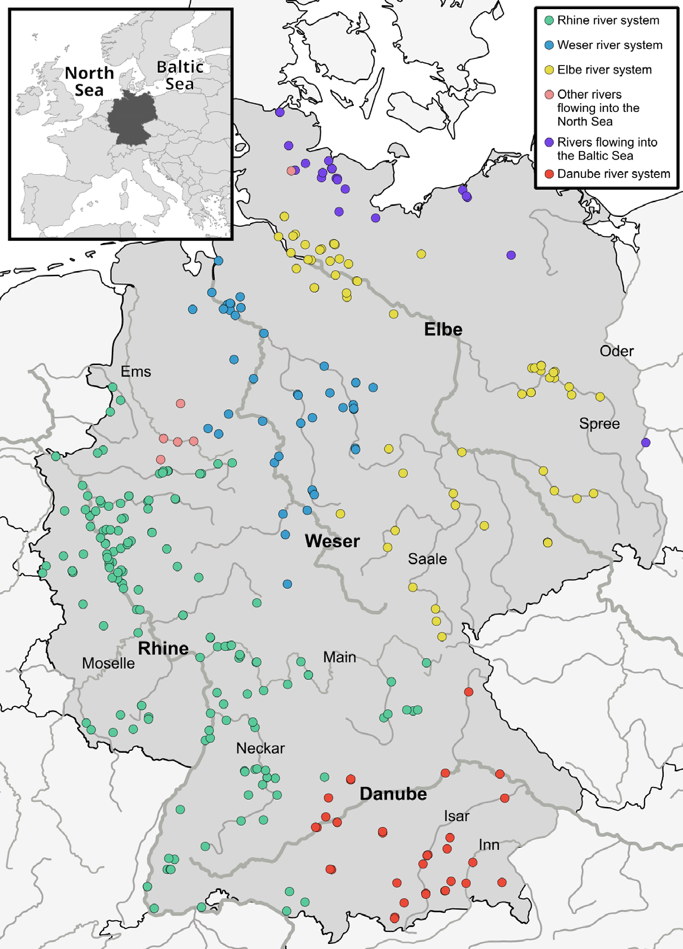
Map of major rivers and sampling spots of the Plastic Pirates in 2016 and 2017 in Germany. The colour of the dots represent the different river systems (or seas the smaller rivers flow into). Modified from Kiessling et al. 2019
Research projects at the GEOMAR Helmholtz Centre for Ocean Research Kiel and Christian-Albrechts-University Kiel
What happens when microplastic enters the environment? Are there any interactions between plastic and bacteria? And what are the consequences for juvenile fish after microplastic ingestion? Scientists from GEOMAR Helmholtz Centre for Ocean Research Kiel and Christian-Albrechts-University Kiel are trying to answer those questions and more.
Aggregation and interaction of microplastic particles
Dr. Jan Michels and colleagues from GEOMAR, the Kiel Cluster of Excellence "The Future Ocean" and the Helmholtz Zentrum Geesthacht study the aggregation and interaction of microplastic particles in the water column. In laboratory experiments, they were able to prove that microplastic particles and natural particles aggregate a lot easier than microplastic particles alone. When the microplastic surface is overgrown by microorganisms such as bacteria or unicellular algae, the formation of aggregates is even faster and more stable. The scientists assume, that microplastic packed in aggregates can sink into deeper water layers of the oceans. This could explain why microplastic is also found on the deep ocean floor more frequently.
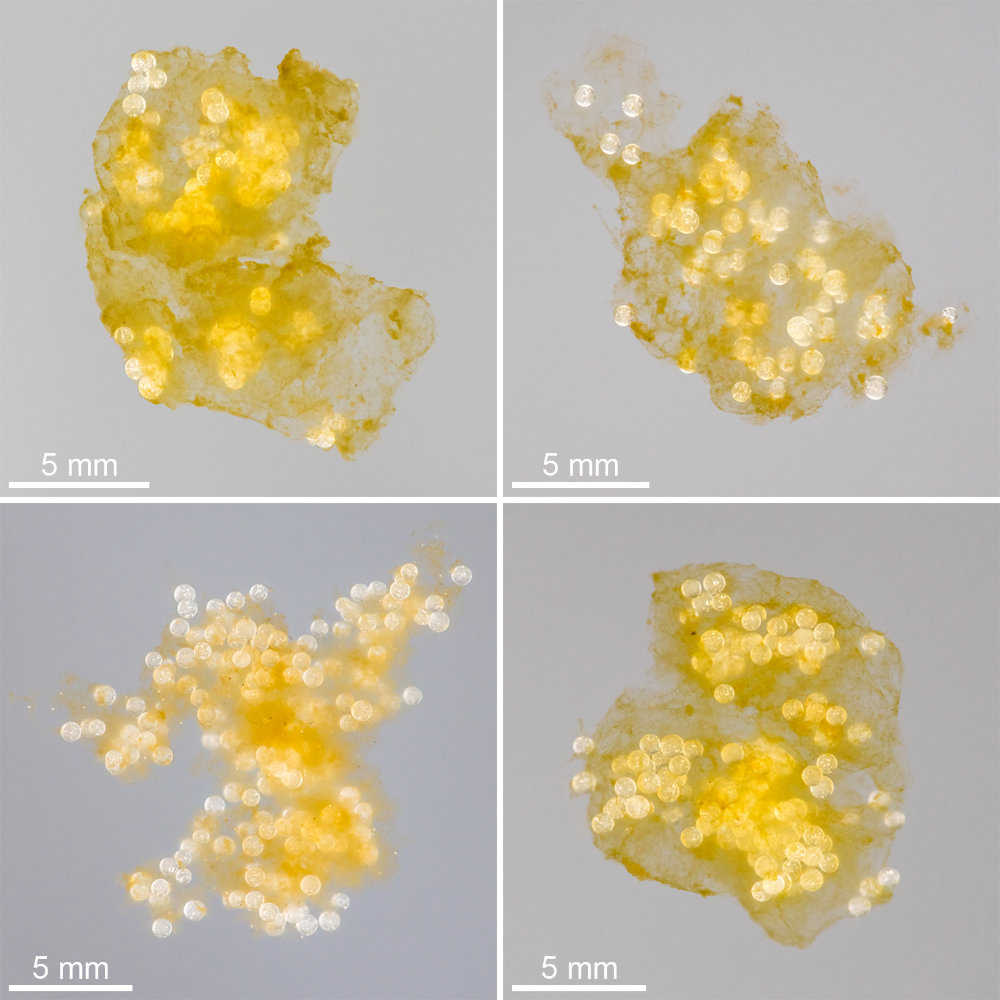
Aggregates containing plastic beads and natural particles from laboratory experiments. Photo: Jan Michels/Future Ocean
Can bacteria in the sea floor degrade plastic- and compostable bags?
Another research project studied, whether bacteria decompose plastic bags in the sediment of the sea floor. The result of Alice Nauendorf and her colleagues: Neither commercial standard bags made of polyethylene, nor so-called compostable plastic bags changed at all after 100 days in the sediment. They neither found a reduction in weight nor any chemical changes of the bags. Therefore, no decomposition had taken place. However, the compostable bags were clearly higher populated by bacteria than the polyethylene bag.

Photograph via scanning electron microscope of the compostable bag after 100 days of incubation in the sediment. Clusters of bacteria can be detected but no sign of degradation. Photo: Joachim Oesert, CAU
Microplastic in the sea floor: a new method for identification
In addition, scientists in Dr. Matthias Haeckel's group at GEOMAR have developed a method to calculate microplastic parts in sediments. Because of their very small size it is not an easy task, since microplastic particles are barely visible with the naked eye and can very easily be confused with sand grains. Plastic parts are first separated from sand and afterwards, a specific microscopy method is used to determine the different types of plastic. This information is particularly important in identifying sources of microplastic.
Professional sailors help collecting microplastic data
A cooperation of sailors and scientists accepted the challenge to better understand the microplastic distribution in the world oceans. Dr. Toste Tanuha (GEOMAR) and Dr.-Ing. Sören Gutekunst (Future Ocean) attached special sensors to two yachts, which participated at the Volvo Ocean Race 2017/2018. The yachts collected data sets of microplastic distribution over a distance of about 83.000 km during 8 months. Preliminary results show that microplastic was even detected at the most remote regions of the ocean.
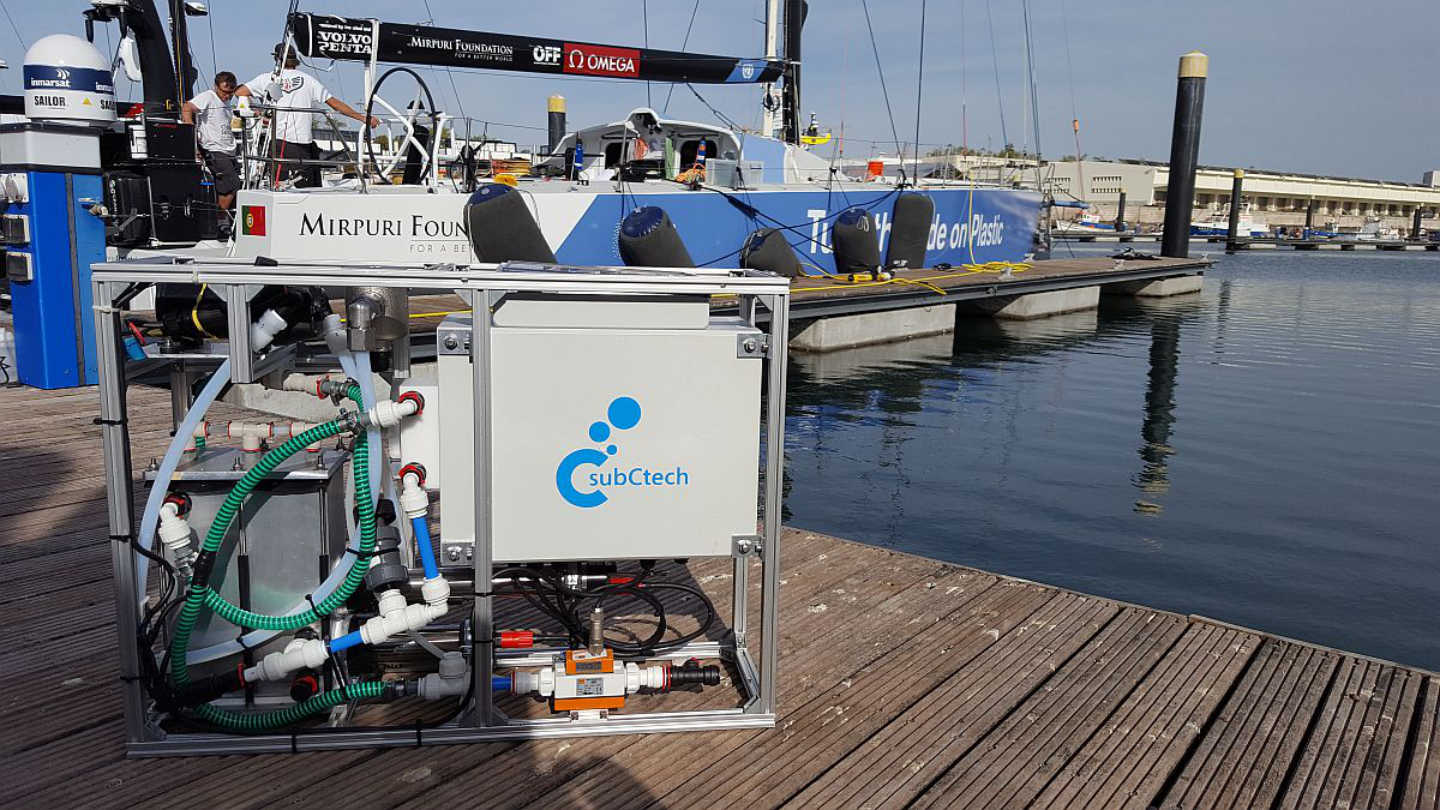
For the Volvo Ocean Race 2017/2018, the sampling unit was installed on the yacht "Turn the Tide on Plastic". The unit collected oceanography data and samples for microplastic analyses. Photo: Stefan Raimund
Microplastic ingestion of juvenile fish
Microplastic ingestion and egestion by juvenile planktivorous fish (palm ruff) were examined in the laboratory by Dr. Nicolas Ory at GEOMAR. He discovered, that black colored microplastics (similar to the fish's common food in the laboratory) were preferred over other colored microplastics. Microplastics as the only food source were mostly spit out by fish and were only swallowed when mixed with food. The study points out that fish of commercial value and ecological importance in the food web, are susceptible to ingest microplastics. Swallowed microplastic was defecated after 7 days on average and even after 7 weeks, no acute consequences were observed. However, potential effects of microplastics on the behavior and physiology of fish still need to be studied.
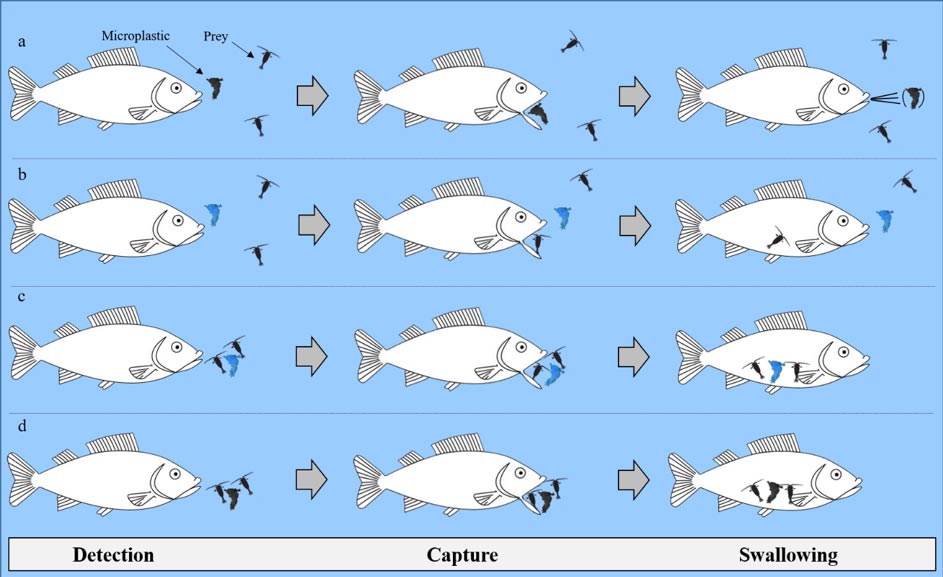
Planktivorous fish prefer microplastics similar to their prey (a) and avoid microplastics different from their prey (b), which are probably only taken in accidentally when floating beside the prey (c). Microplastics ingested alone are almost always spit out (a) and are most likely to be swallowed when they are mixed with food in the fishs mouth (c,d). Source: Ory et al. 2017, Ory et al. 2018
Bacteria communities on plastic surfaces: a new method
The Scientist Dr. Cathleen Schlundt developed a new method to visually identify bacteria on plastic surfaces at the Marine Biological Laboratory in Woods Hole (now working at GEOMAR). She and colleagues generated different kinds of probes in order to visualize different bacterial groups (e.g. Bacteroidetes, Alphagammaproteobacteria or Vibrionaceae) at the same time under a special microscope. With the help of this method, bacterial distribution on plastic surfaces of several groups, their interaction among each other and with plant cells can be analyzed. This method was already applied to samples from the Atlantic Ocean and North Sea. It was detected that bacterial communities were evenly distributed on polyethylene surfaces and were in direct contact to other groups and plant cells.
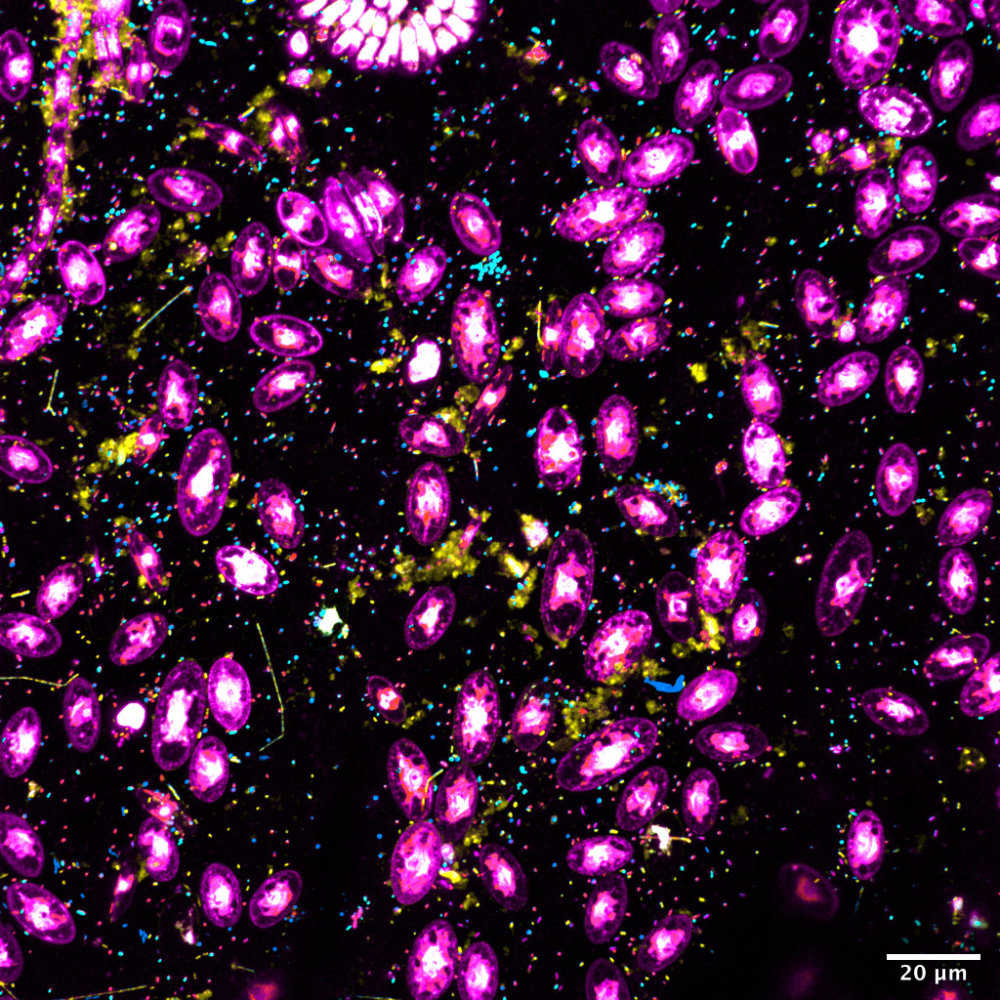
Micrograph of fouling on a Polyethylene piece after one week of incubation at Woods Hole dock, USA. Pink big: Phytoplankton, pink small: Gammaproteobacteria, light blue: Rhodobacteraceae, dark blue: Bacteria, yellow: Bacteroidetes. Photo: Cathleen Schlundt, GEOMAR
Microplastic in the Baltic Sea: a long-term survey
Since 1987 GEOMAR investigates the food wed in the Baltic Sea at different locations every year. Plankton samples and gut content of herring and sprat are stored since then and were now analyzed on microplastic by partners in Denmark in cooperation with Dr. Jan Dierking (GEOMAR). Surprisingly, the microplastic concentration in the water stayed constant with a mean value of 0.21 ± 0.15 particles per cubic meter from 1987 until 2015. Microplastic was detected in 20% of the examined gut contents, which were predominantly microfibers. No temporal trend was observed as well. Given the temporal stability of the microplastic concentration in the water column, it is important to investigate the microplastic export rate in the sediment of the Baltic sea floor.
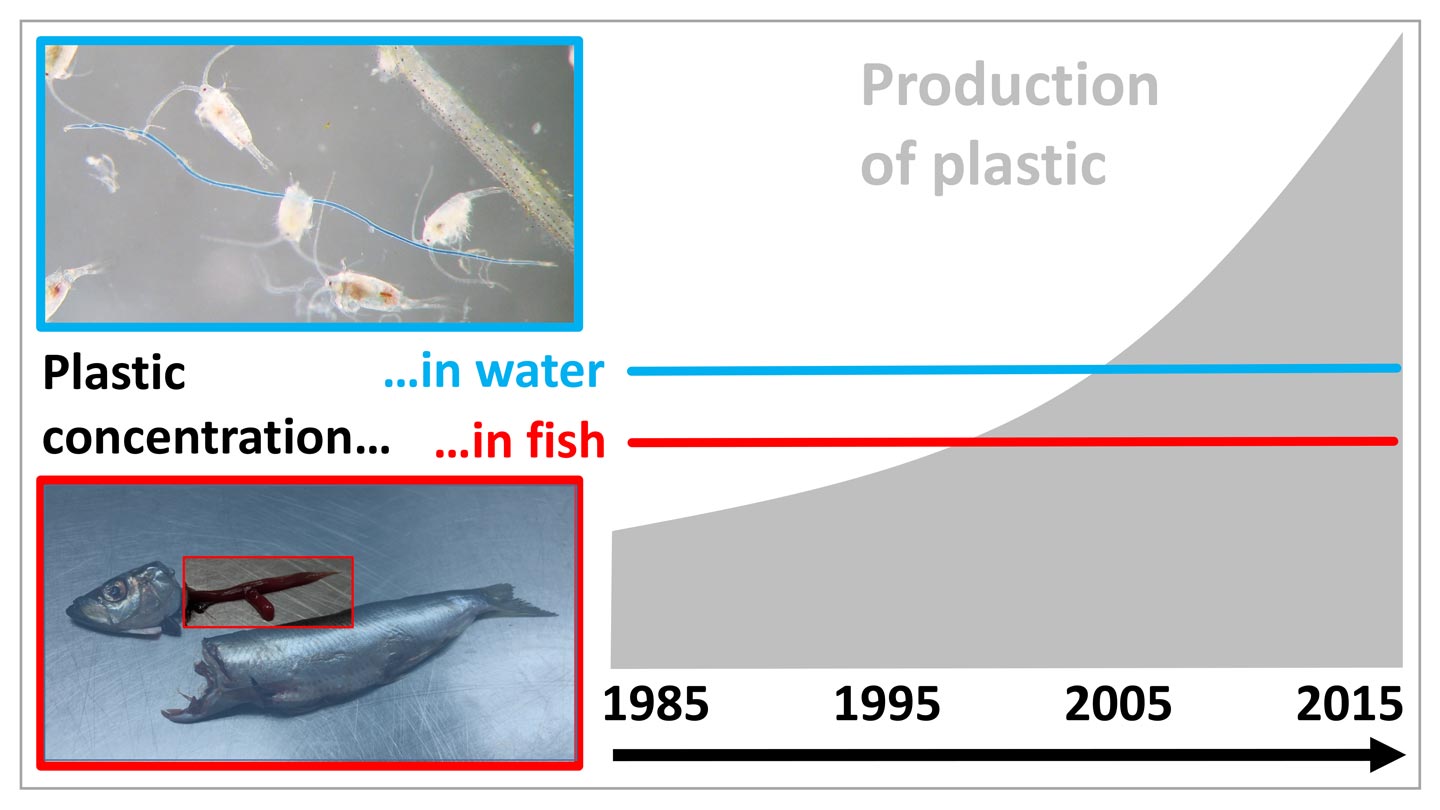
Microplastic concentration in the Baltic Sea and in Baltic fish (herring and sprat) stayed constant for 30 years. Source: Beer et al. 2018
Microplastic 54°N: Microplastic at our coast
The project of the Kiel Cluster of Excellence "The Future Ocean" has the goal to
investigate the microplastic concentration at the Baltic Sea coast of
Schleswig-Holstein. Sediment samples from the drift line at 10 locations between
Flensburg fjord and Luebecker bay were taken in winter and spring 2018. The
samples were further processed at GEOMAR. A special separating system isolates
microplastic particles from sand grains. With its low density, microplastic
floats up to the surface and can be removed with a sieve. On a filter, the
plastic particles can be sorted under a microscope and with RAMAN spectroscopy
the chemical composition of its surface can be detected to make sure that it is
plastic.
More information about this project:
http://www.oceanblogs.org/mikroplastik54n/
https://www.youtube.com/watch?v=SE7Xcv7X08Y&feature=youtu.be (German
version only)
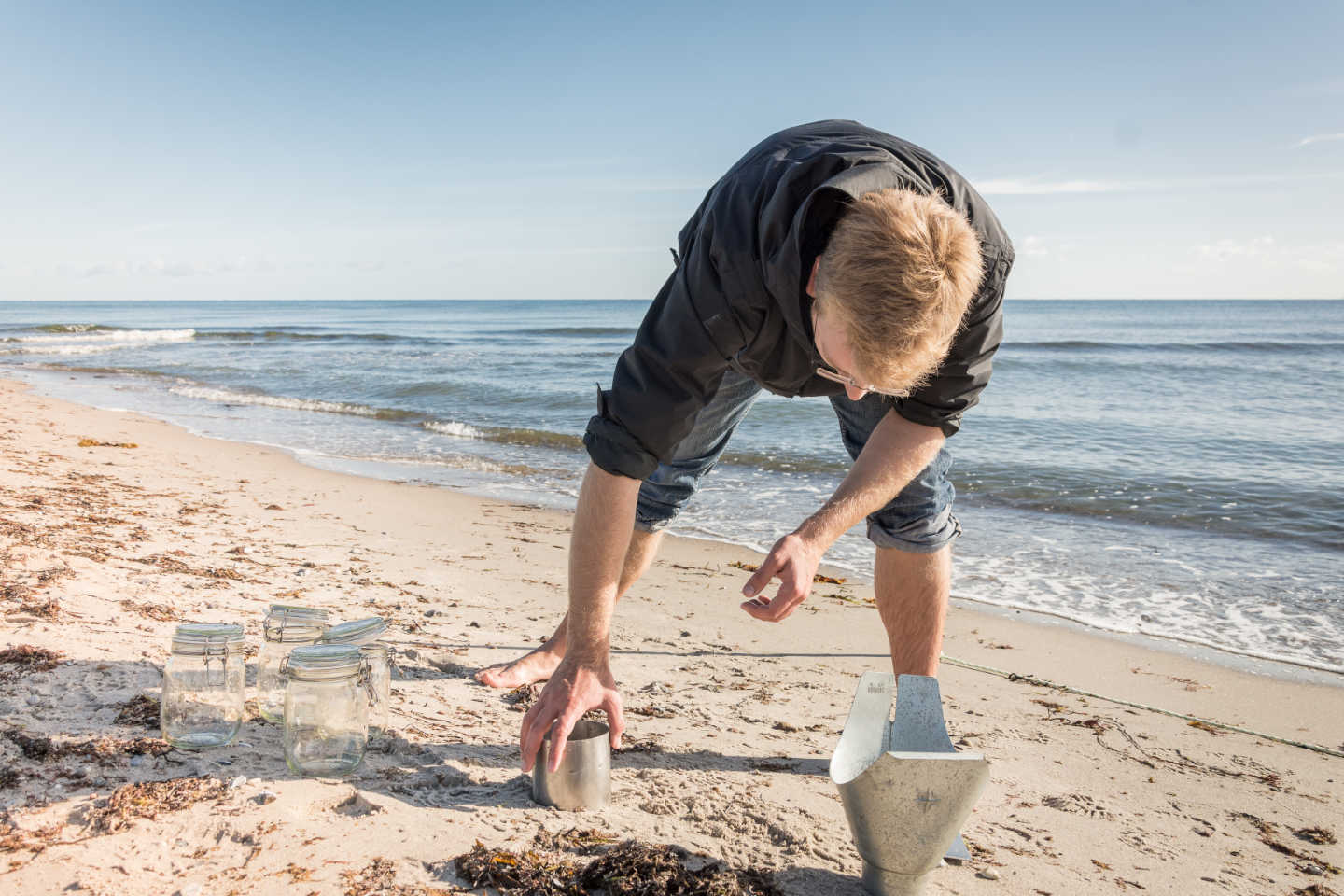
Kevin Schröder takes sediment samples for microplastic investigation. Photo: Fenja Hardel, Exzellenzcluster "Ozean der Zukunft"
Plastic and plasticizers: How much leaks into the environment?
The PhD student Jeyakumar Dhavamani from Kiel University studies the toxicity of different kinds of plastics and its plasticizers. Plasticizers are substances which give plastic its special properties like flexibility, durability and its resistance to degradation. Plasticizers are not chemically bond to the plastic polymers and can leak into the water. Also, they are often toxic and can be carcinogenic. In his current project, Jeyakumar Dhavamani studies the leakage of Phthalates (plasticizers) from different plastic materials (LDPE, HDPE and recycled plastic) under natural conditions.
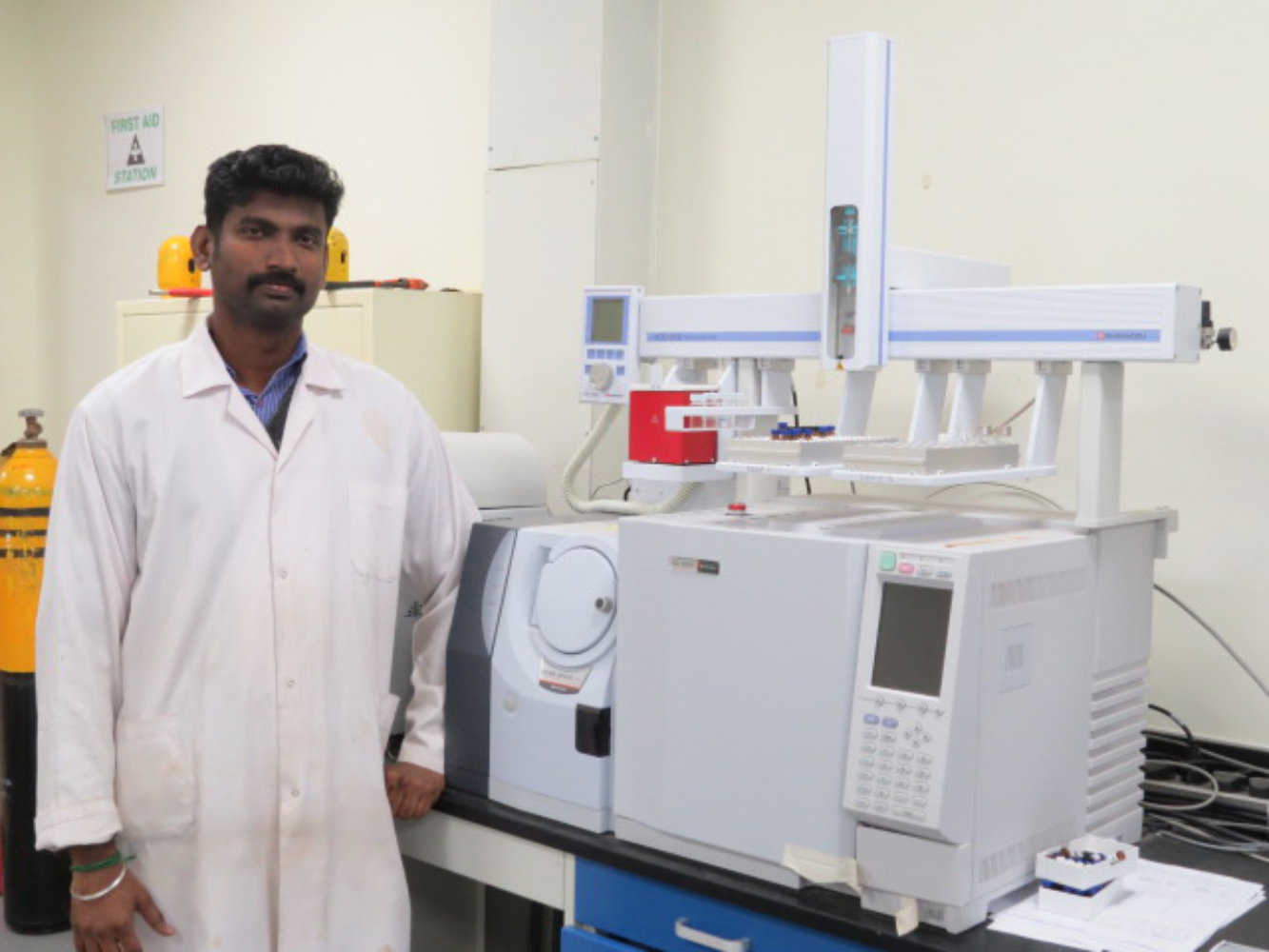
Photo: Sivaraman Chandrasekaran
What are the effects of microplastic on the common mussel of the Kiel fjord?
The common mussel Mytilus edulis feeds on plankton and filters many litres of seawater daily. While doing so, it is selective with the size of its food. But what happens, if microplastic has the same size as its food? Thea Hamm asked herself that question. The scientist working at GEOMAR wants to find out which microplastic concentration and exposure time leads to a negative reaction of the common mussel. A long-term laboratory experiment is planned in which mussels are exposed to different microplastic concentrations. After certain points in time, the physiological fitness is measured via growth and rate of filtration. For the experiment, the microplastic concentration in the Kiel fjord will be measured first to be able to work with realistic numbers.
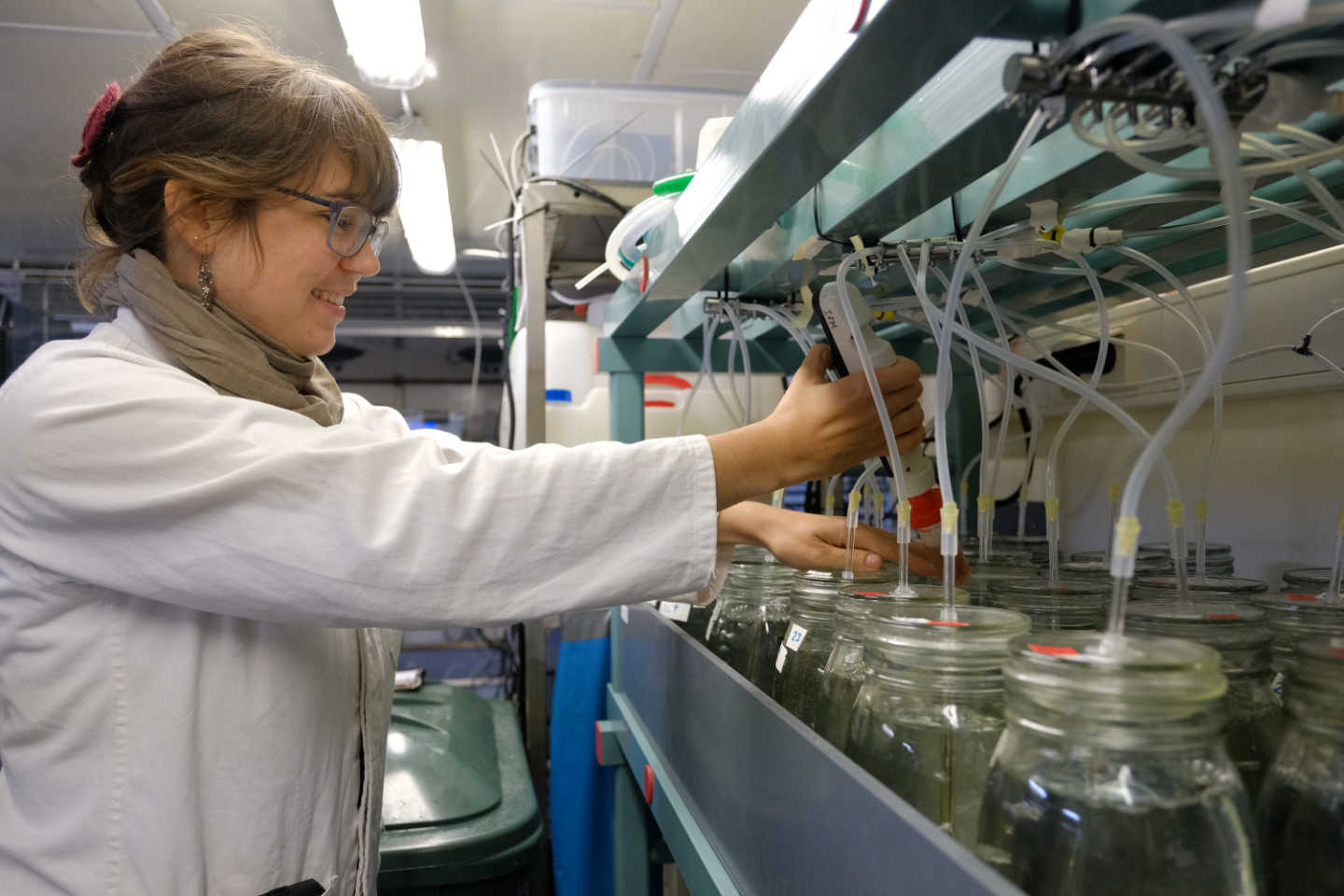
Thea Hamm observes in the laboratory if mussels ingest microplastic under environmental concentrations and if they are affected after long term incubation. Photo: Jan Steffens, GEOMAR
GAME is an international training and research program in marine ecology which connects applied research and the education of young scientists. Every year, identical experiments, beyond geographical and climatic borders, are carried out in very different locations in the world at the same time. The 11th GAME project in 2013 was the first of in a total of three GAME projects looking at the influence of micro plastics on invertebrate marine organisms. For this purpose, sediment feeders, such as the lugworm, were stored in sediment enriched with micro plastics for two months. Through this, the research team carried out important pioneering work and collected valuable data for follow-up projects. In the following year, the same research institutes came together for a follow-up study. The experimental setup changed slightly compared to the previous year, since in 2014 the teams worked with PVC and not polystyrene, as in 2013. Moreover, the animals were exposed to different particle densities for the first time, in order to test just how much micro plastic pollution would produce negative impacts during the experimental period. In 2016 GAME participants will once again deal with the problems of micro plastics. This time, they will test, whether the influence of micro plastics on invertebrate marine organisms changes if another environmental stressor, in this case heat stress, is added. Thus they will study the potential interactions between two factors of global change.
Mareike Huhn, doctoral candidate and former participant of the GAME program at the GEOMAR Helmholtz Centre for Ocean Research Kiel has founded the support association Marine Conservation South East Asia e.V. (MC-SEA) together with a team of marine biologists, diving teachers and project managers with many years of experience with Asia. The organization advocates for a sustainable coexistence of humans and the sea in Southeast Asia with the aim of preserving the ecological balance in the region and protecting the biodiversity of the region under water and on the coasts. MC-SEA therefore educates the coastal population in Southeastern countries on how to use natural resources sustainably and dispose of waste products in an environmentally sustainable way. Since 2013, the main focus of attention has been on the establishment of a functioning waste disposal system on the Indonesian Banda islands in the Indo-pacific, one of our earth's last paradises. For this purpose, MC-SEA is providing the in total seven villages on the main island Banda Naira with waste collection for two months. This will be done by volunteers with trolleys and motorcycle pickups who drive from door to door twice a week and collect the accumulated waste in empty rice bags. After two months the villages are expected to continue and finance the system themselves. Apart from this, since February 2014, weekly waste collection activities have been taking place at different beaches on the island of Naira. These serve primarily an educational purpose. Most people are not aware of the negative impacts of waste on the environment because of insufficient education. Each week a new school class participates in the activities. The preparation of the participating children is one of the most important aspects of these days of action. However, in the long-term a solution for recycling must be developed directly on Banda since removal of the waste is too expensive due to its secluded location. Since the piles of garbage are growing world-wide, there is an urgent need for a sustainable and universally applicable solution for the disposal of waste in the long-term, because in many countries waste is still being burned in the front gardens or disposed of in the environment.
